Buy ANY 3 Resources. Get the 4th FREE! 👉 SHOP NOW 👈
Making persuasive writing fun to teach and learn.
- April 21, 2021
How do you make persuasive writing fun in the classroom?
Lots of the time, teachers and students alike don’t enjoy writing lessons. It can be a challenge getting ALL students motivated to put pencil to paper.
That is where we step in to help you change that with these 5 fun strategies you can start using tomorrow to make persuasive writing enjoyable in your classroom.
We want to begin by saying, children love learning through games, and as teachers, we have witnessed the benefits.
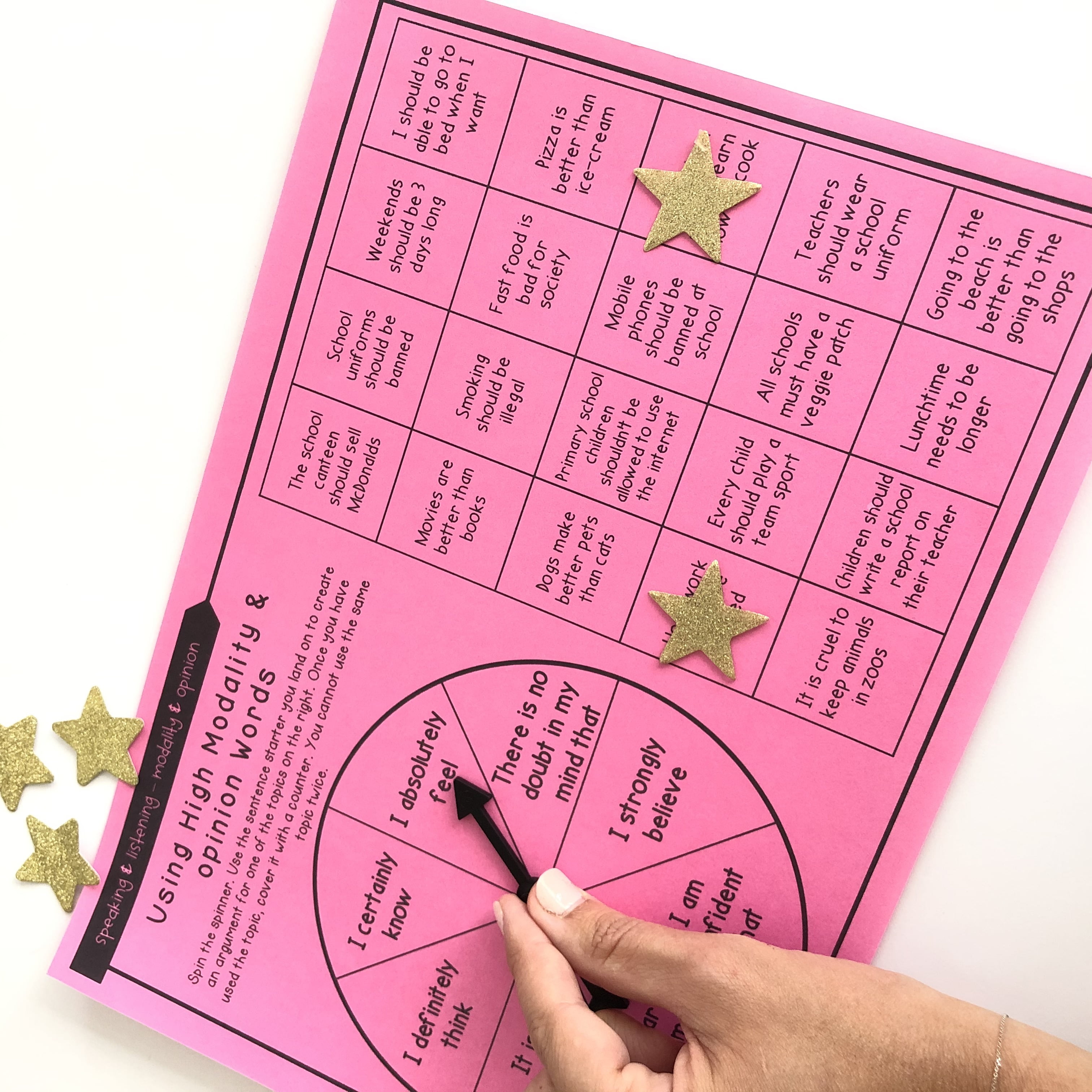
These tips include a range of games for individuals, pairs and, whole groups that will have your students excited when you tell them that writing is next up on the daily timetable.

1. Would you rather game
Build the field and get students talking with a Would You Rather game. Kids absolutely love playing this game, and it is an excellent way to get kids informally using persuasive language. An ‘Agree or Disagree’ game is another alternative you could play as a class (just make sure you include some funny or outrageous statements).
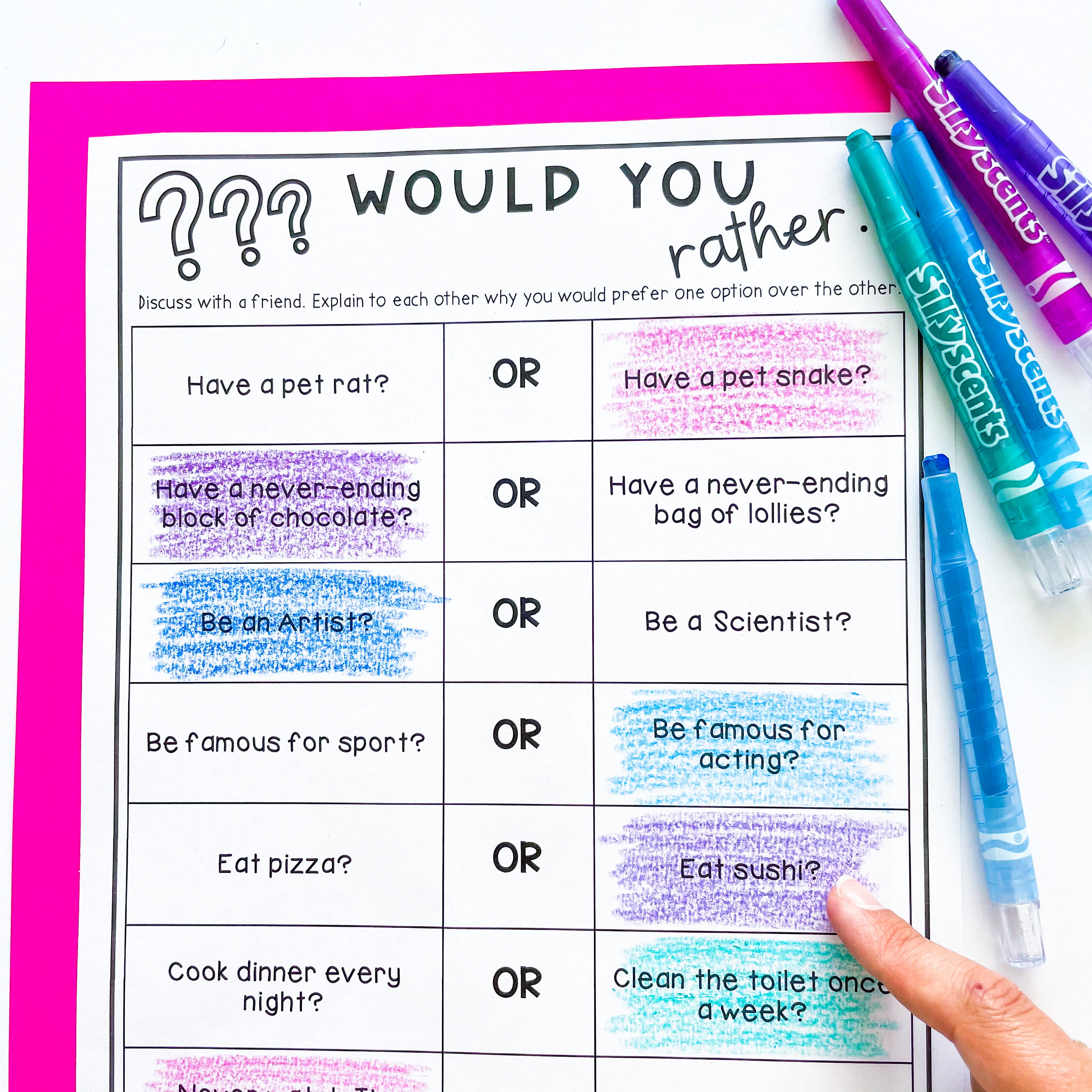
2. Spinner and dice games
We know that speaking and listening is vital when it comes to writing development. Spinner or dice games are an engaging and different way for students to work on specific language conventions and have fun at the same time. We like to set games up as fast finisher activities or send them home for students that need extra support.
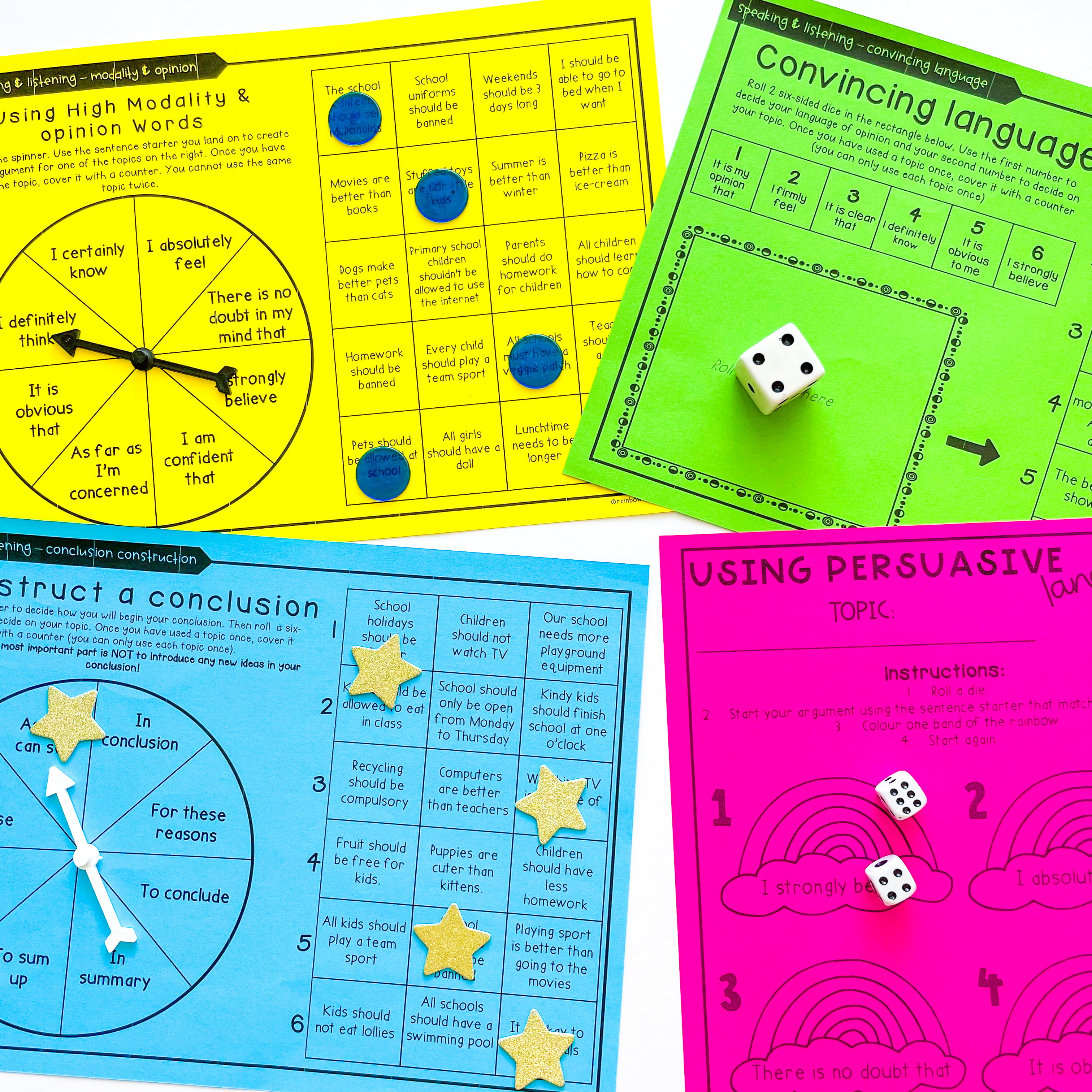
3. Word wheels
These are a great alternative to word or vocabulary walls. You could have students make their own word wheels to use as a reference when writing or simply speaking before writing. They can be less overwhelming for students by presenting multiple options one by one.
We have actually seen a creative teacher make large word wheels and pin them to her persuasive writing display. The students had the structure to refer to, examples, and could also access the word wheels on the wall if they needed help when writing.
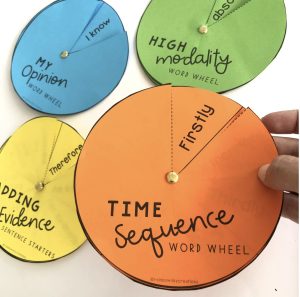
4. Partner writing
Don’t discount the learning opportunities that students obtain from working together on a piece of writing. Not only can they discuss and talk through their arguments but also mentor each other throughout the writing process. Peer or partner writing is another way to get reluctant writers engaged in the process.

5. Student choice and voice
Give students a bingo board or a range of topics for them to choose something they are passionate about or know about. As adults, we know it is easier to write about something we know, and kids are exactly the same. By giving students a choice it will allow them to feel confident in the content and, therefore, be able to focus more on the punctuation, language conventions, and spelling required of them when writing.
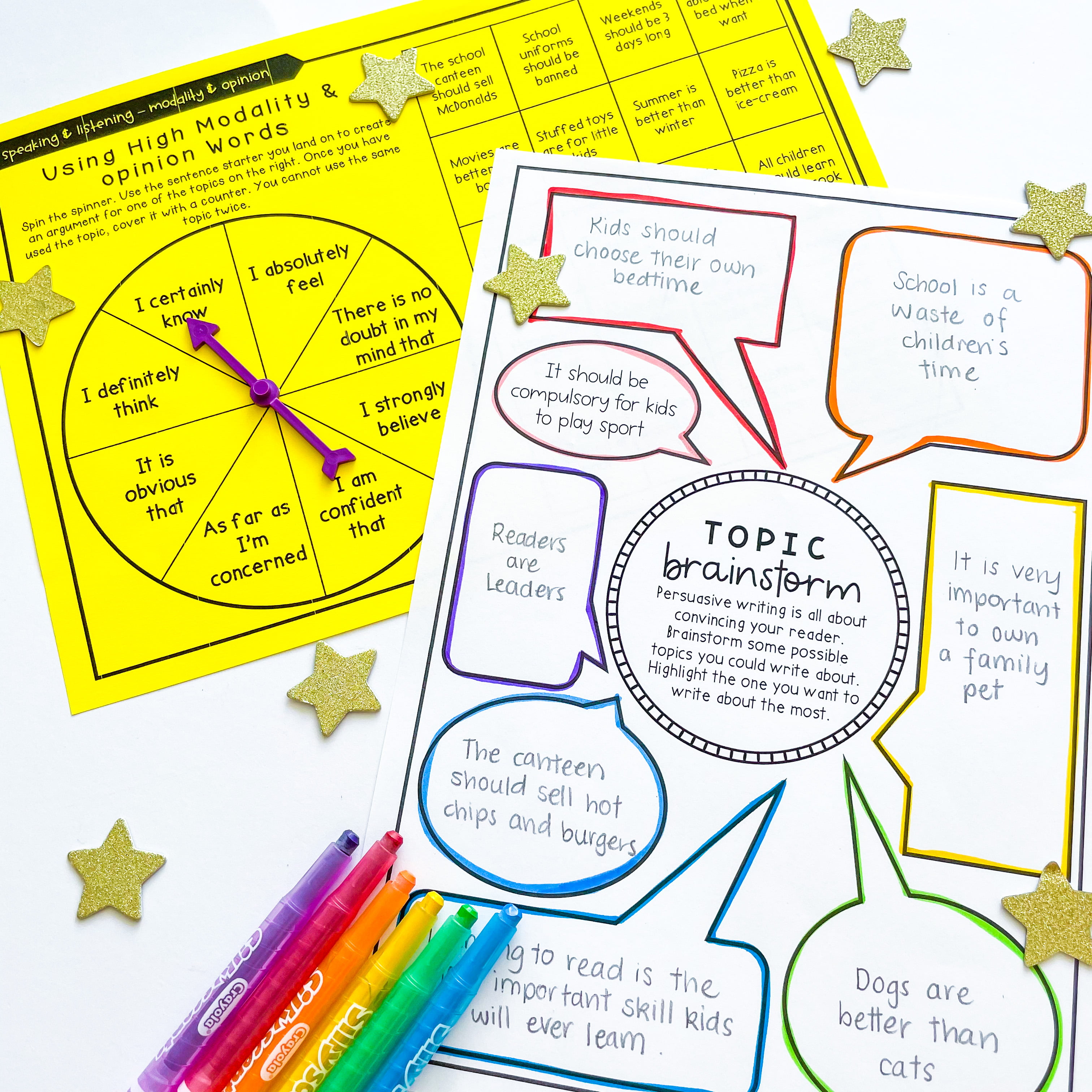
Create confident and enthusiastic writers with these persuasive writing activities and games. And remember, writing lessons don’t always require students to be sitting at a desk writing. Mix it up and make it fun!
Loved these ideas and want to remember them later? Pin the image below.
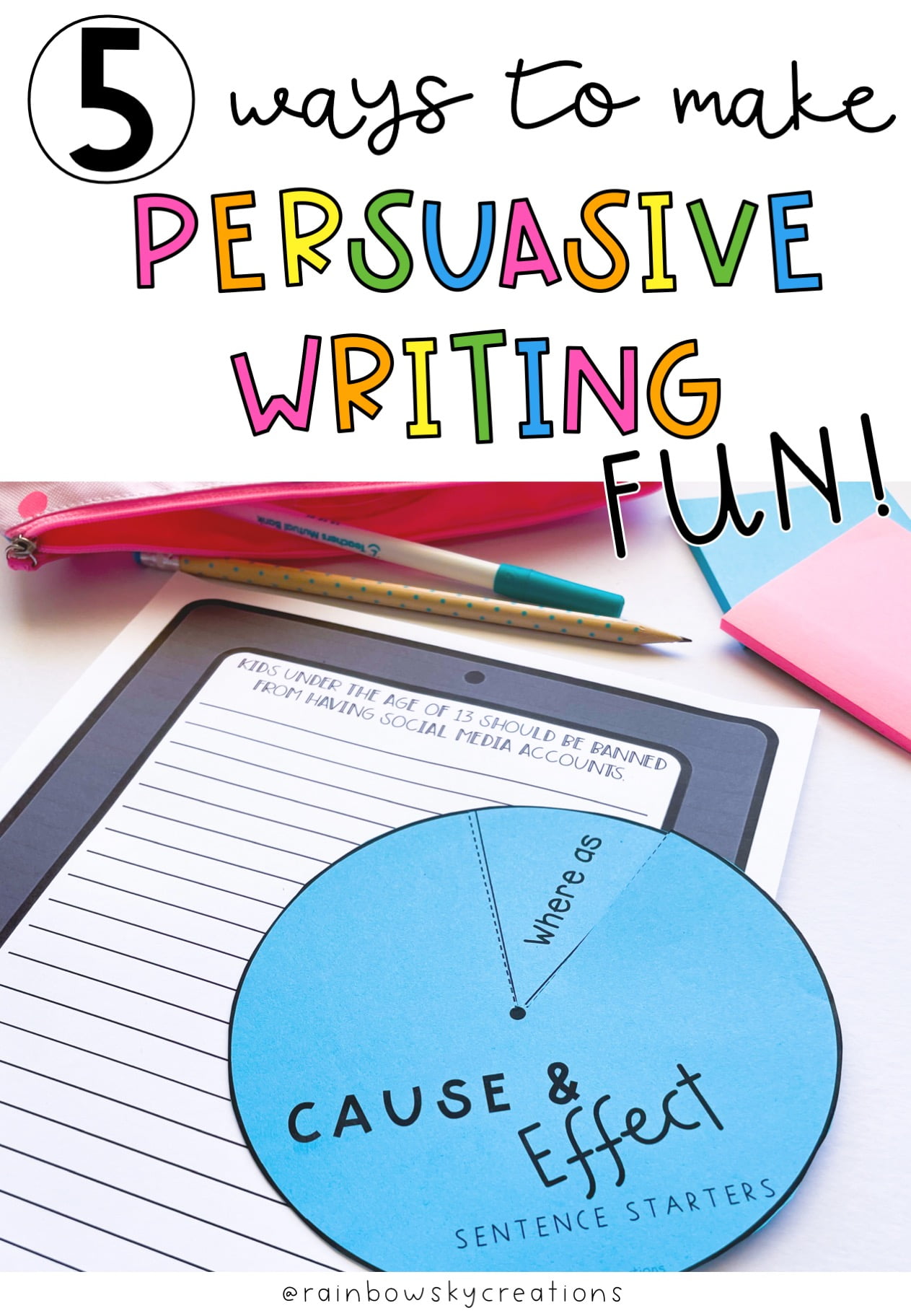
Need help when it comes to planning and preparing your persuasive writing lessons? Check out our ready-to-print resources for Grades 2-3 & Grades 4-6.
“Fabulous addition to a unit we’ve taught many times before. This resource brought new perspectives & tasks to help revamp what we do.” Kristy T

WHAT IF YOU COULD MASTER SETTING UP AND RUNNING YOUR READING GROUPS IN JUST ONE WEEK?
Imagine running a reading group program which is uncomplicated, easy to implement and stress free. .., introducing…, transform your reading groups.
- Discover a streamlined system to take control of your reading groups.
- Learn our step-by-step instructions.
- Create a time in the day you and your students love.
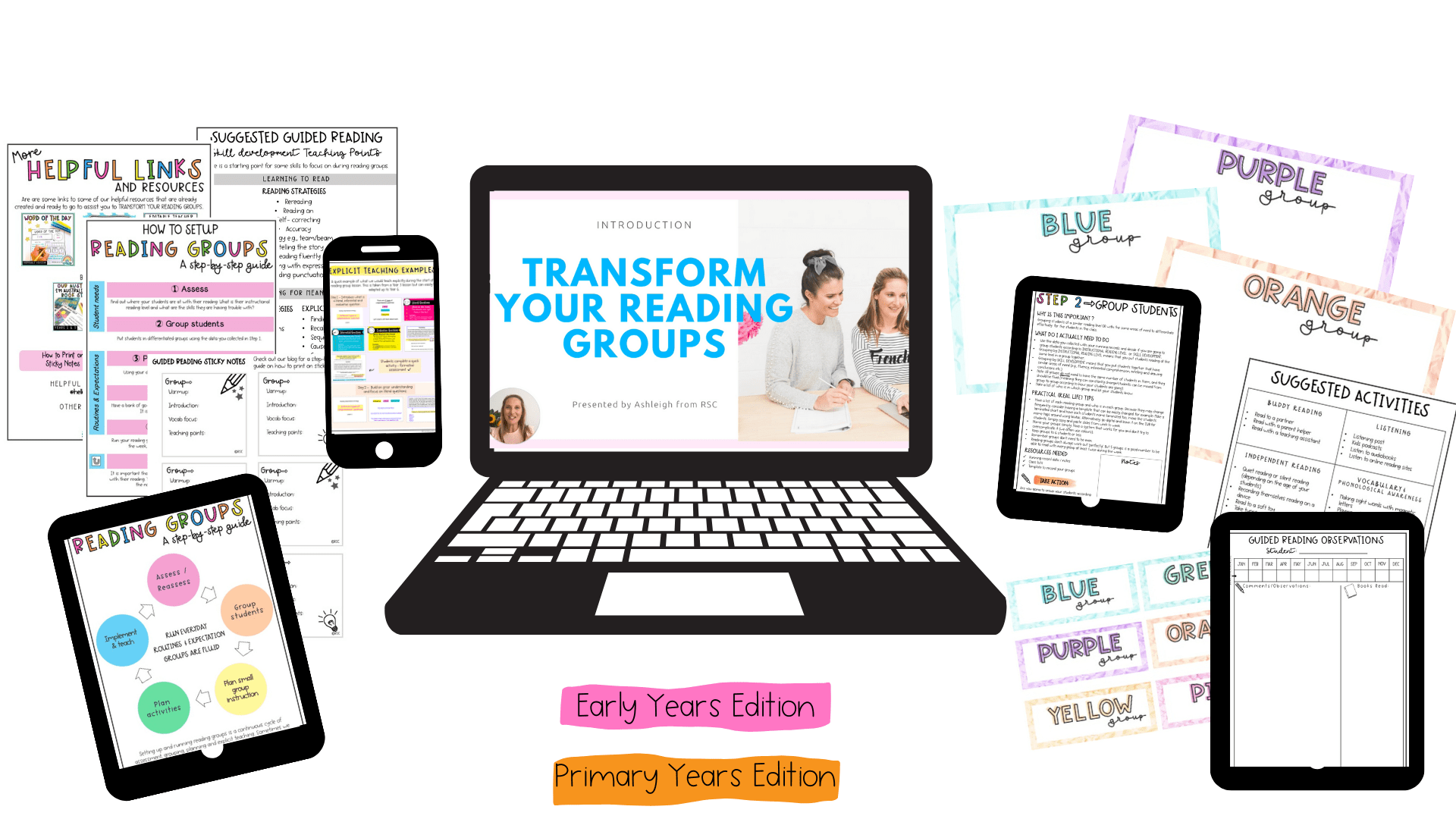
Click here to join us and TRANSFORM YOUR READING GROUPS.
What to read next:.
Ways to emotionally prepare your students for NAPLAN
8 Tips for Efficiently Running Reading Groups
Time Saving Strategies for Teachers

share this post
How to conquer maths anxiety leading up to naplan, attention grabbers for teachers (that don’t involve using your voice), report card help – how teachers can use chat gpt to help write reports, 5 fun valentine’s day math activities for february, member logins.
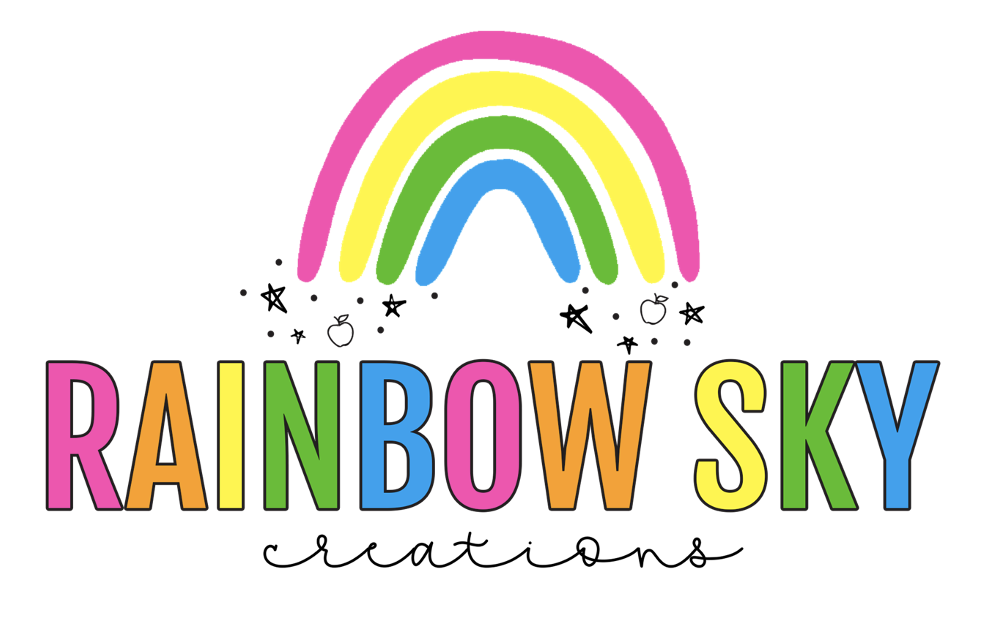
Rainbow Sky Creations acknowledges the Dharawal people and Whadjuk Nyungar people, the traditional custodians of the lands on which they live, work and learn. They pay their respects to the past, present and emerging Elders of this nation, and supports the cultural, spiritual and educational practices of First Nations peoples.
- Privacy Policy
- Terms & Conditions
- Site Maintained by Nyssa
Let's hear from you! Text us!
What is the best way to teach reading? Today, literacy specialist Malia Hollowell talks to us about best literacy practise.
Malia firmly believes that you don’t need to be a reading specialist to be an exceptional reading teacher. In this episode, she shares tools and strategies that will help all teachers (and therefore students) achieve success.
During our chat, we talk about:
- Why is the Science of Reading something teachers need to be paying attention to
- How SOR doesn’t mean we need to throw everything away and start fresh – it is all about the tweaks!
- Small changes teachers can make to make their literacy instruction more SOR aligned
- What reading lessons look like in classrooms from Kindergarten all the way through to Grade 6.
We also touch on some of the literacy trends as well as things teachers have been doing for decades and ask Malia if we need to keep them or ditch them all together!
This is a fun episode that will provide you with inspiration, confidence and best practice strategies when teaching reading.
Before you head off, please share this episode with another teacher because sharing is caring!
Rainbows ahead,
Ashleigh and Alisha
Resources mentioned in this episode
Connect with Malia on Instagram
Sound Mapping Freebie
Grab the Science of Reading Quickstart Bundle
Get a copy of our FREE guide: How to Efficiently Run Reading Groups
APPLE PODCAST | SPOTIFY | GOOGLE PODCASTS

Teaching Argumentation and Persuasion: 6 Engaging Activities Beyond the Argumentative Essay
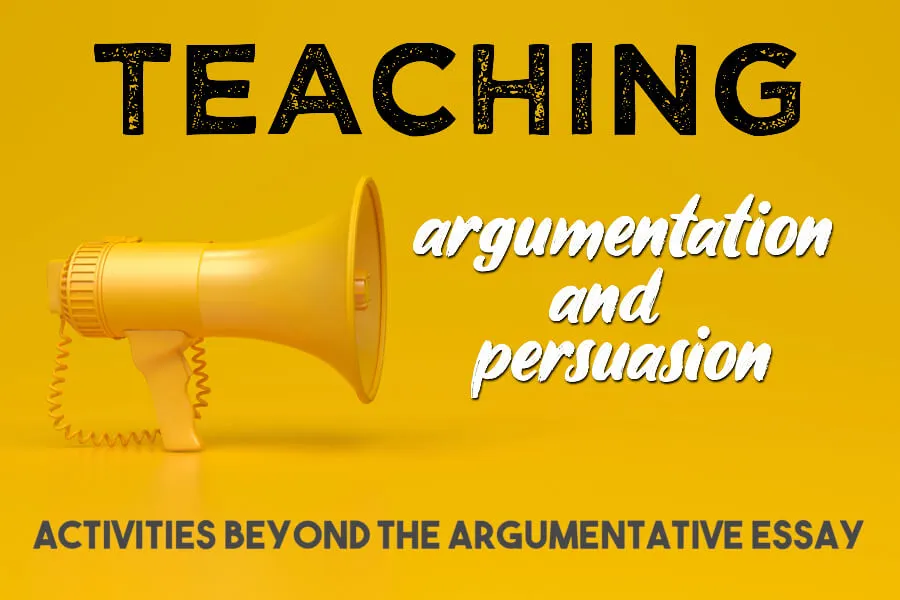
There are many engaging activities to use when teaching argumentation and persuasion beyond the classic essay. While the argumentative essay can certainly be effective, try something new with one of these 6 engaging activities. Your students will be excited and eager to apply argumentation and persuasion in the classroom and beyond.
When it comes to teaching argumentation and persuasion, I’m like a kid on Christmas morning. I’m eager, excited, and full of energy. Yet, over the years, I’ve found that my students don’t always meet me with the same enthusiasm. Instead, they roll their figurative eyes at the thought of writing yet another essay.
I had to do something to save my favorite holiday– I mean unit– of the year.
I’ve spent more hours than I’d like to admit, wracking my brain for activities that would make teaching argumentation and persuasion, dare I say, fun! But the time and effort paid off. When I started implementing activities beyond the argumentative essays, my students were engaged and active participants. It was a win-win.
Lucky for you, I’ve done the work (and put in the time) so you don’t have to. Instead, simply keep reading to uncover some of my secret weapons for teaching argumentation and persuasion. The following activities can be used instead of or in conjunction with the classic argumentative essay. It’s totally up to you and what will best suit your students’ needs. Regardless, you don’t have to spend the hours brainstorming from square one. You can thank me later. In the meantime, read on, my teacher friends!
Laying the Foundation for Teaching Argumentation and Persuasion
Before jumping into one of the activities below, you need to set your students up for success. Therefore, be sure to teach the essential concepts for effective argumentation and persuasion. Afterall, both argumentation and persuasion are cornerstone communication skills in the 21st century.
So, not only do you want to do these topics justice for the sake of your classroom. But, they’re also some of the most transferable skills your students will use in the real world.
Note: if you’re just looking for the activities, no problem! Keep scrolling– I promise they’re there.
Understanding the Difference Between Argumentation and Persuasion
While these two topics are often taught together, it’s important for students to know that they aren’t exactly synonyms. Instead, you could argue (see what I did there) these two concepts act as compliments to one another. In many cases, persuasion can strengthen an argument, and vice versa. But again, they’re not exactly the same when it comes to speaking or writing. (However, I find it useful to remind students of one of the most important aspects they do share: there has to be at least two sides.) You can clarify the major differences between the two by looking at the main goal for each type of writing or speech:
- The goal of argumentative writing is to get the audience to acknowledge your stance on a topic. Moreover, a strong argument shows the reader your viewpoint is valid and deserves consideration. Therefore, argumentative writing is heavily rooted in logic and facts and addressed counterclaims.
- Goal of persuasive writing is to get the audience to agree with you and your stance on a particular topic or viewpoint. While logic most certainly strengthens persuasion, there is also a heavy emphasis on emotional elements as well.
The truth is, the two are often used hand in hand in the real world with everything from marketing and public service campaigns to politics and law. And, in most cases, persuasive writing is more personal and passionate for students. Therefore, I strive to teach the two together to increase student engagement and real word application. Talk about a dream duo for students and teachers alike!
Rhetoric and Rhetorical Appeals
I absolutely love comparing persuasion and argumentation to art. Why? Because it’s a true craft. Do I explain it that way to my students? Abso-freakin-lutely. Why? Because they need to understand that presenting a sound and persuasive argument is a skill. That these writing and speaking skills take time and effort to develop.
Enter: Rhetoric. I always begin this unit by defining argumentation, persuasion, and rhetoric, explaining how the latter literally means the art of persuasion. Then, I introduce the three main rhetorical appeals (shout out Aristotle). Rather than simply giving the students the definitions of ethos, pathos, and logos, I begin by asking questions to help reveal the definitions. Here are some of the questions I use– and that you can most certainly steal for your own classroom:
- To introduce ethos , I ask, “Who would you trust to give advice about toothpaste? Why?”
- To introduce logos , I might ask, “If you wanted to learn how to build a successful business, what is the benefit of a successful entrepreneur giving you step-by-step guidance?”
- To introduce pathos , I ask, “Think about a time where you got emotional during a commercial, song, or movie. What was it that made you so emotional?”
The Power of Words
Once students have an understanding of these essential definitions, it’s time to move on to a more abstract, yet highly significant, concept: the power of words. This is where I introduce the importance (and power) of diction. This is the perfect time to explain how words impact reader/audience experience.
One of the simplest examples to make a case for this claim is asking students to analyze the difference between the terms house and home. I’ve never had a class not come to the conclusion that a house is a structure and place of living, where a home is a place filled with love.
To round out the discussion on why and how words have an impact on the audience, introduce connotation and denotation. Spending a handful of minutes explaining the emotional meaning behind words (connotation) can be a game changer. It reminds students that there is, in fact, emotional power in the words we use. To drive the point home, you can ask them to compare times when they were upset vs. angry vs. furious.
A Fun and Engaging Warm-Up Activity for Teaching Argumentation and Persuasion
What tween or teen doesn’t like arguing with adults? (Trust me. They’re far and few between.) In other words, students will eat this activity up. Rather than focusing on deep and heavy topics that require a great deal of research and unpacking, this activity is a lighthearted warm-up. The goal is to get students to start thinking about what goes into a sound and persuasive argument.
- Arguing with “Adults”
Working independently or in small groups, students will pick a “silly” or lighthearted topic. Encourage them to think of things they’d like to convince their parents, teachers, or other adults. Since these topics are light hearted and often come from a place of passion, students will have no problem coming up with reasons why their curfew should be extended by an hour or two or why homework should be abolished. They’re excited to argue why their parents should buy them a car or why a puppy is a must-have addition to their family.
Next, allow students five minutes to choose a topic and brainstorm their argument. Then, give them 10-20 minutes to write their argument. (The timing of this activity is flexible, so you can adjust it based on the structure of your class.) After they write out their argument, it’s time to share– and let the discussion unfold. As each student (or group) shares their argument, have fun playing devil’s advocate. Challenge them to push their arguments and reasoning further.
While you might want to guide the students through the discussion, let them really come to terms with the idea of what makes a sound and persuasive argument. And if you really want to play up the fun? Challenge the other students to play that role! Have your students in the audience play the role of the adults to whom the argument is targeted. This will challenge students to find holes in the arguments, brainstorming ways to make an argument even stronger. Additionally, it challenges them to think about the importance of audience perspective , looking beyond their own interests, blind spots, and biases. The end result? Develop a list of student generated “check-points” for an argument that is both powerful and persuasive.
Engaging Activities for Teaching Argumentation and Persuasion
Watching TV. Driving down the highway. Scrolling through social media. The art of argumentation and persuasion are everywhere . So, why not bring some of those real-life examples to your classroom? Because the truth is, persuasion and argumentation comes in all shapes and sizes. Therefore, it might be time to look beyond the traditional argumentative essay. And with these activities, you can.
An oldie but a goodie. In fact, discussing teaching argumentation and persuasion wouldn’t feel right without some sort of debate. So, to begin this student-centered activity, select (or have students choose) a topic to argue. This can be a murder or crime– and you can even have fun with historical topics like the Salem witch trials if it’s around Halloween or you’re reading The Crucible . Alternatively, you can root your debate in an ethical dilemma or an essential question. Generally speaking, you can look toward real life events or literature for inspiration. You can even head to your state bar association website for mock trial resources and cases– like these from the state of NH . As long as there is evidence to be found and a case to make, you should be good to go.
Before really diving into the mock trial, spend time reviewing the basics of the justice system and trials. Then, once you choose your topic, divide students into teams of prosecution and defense. Once the teams are determined, students can dive into researching and crafting their arguments. However, be sure to emphasize the need for evidence based claims while also discussing the power of persuasion in the courtroom. (There are plenty of video clips you can show and analyze to see these two elements in action.) Each group, both the prosecution and defense, are responsible for crafting an opening statement, a claim, a rebuttal, and a closing statement. For smaller classes, you can serve as the judge and jury. For larger classes, you can run several trials, letting the other groups act as the jury if they’re not presenting. Either way, students will be far more eager to win the jury over with their evidence than they are to write a paper.
There’s no better way for students to show off their new persuasive skills and knowledge of ethos, logos, and pathos than to craft their own arguments. And a mock trial allows them to do so in a way other than the classic essay. But with a verdict on the line, there’s a lot at stake. Therefore, this activity amps up eager participation.
Mock Trial Teacher Tip. Mock trials make debating more exciting– especially if you really play up the trial theme. (Have an old graduation gown? Use it as the judge’s robe! A wig? Yes please! A gavel? A must.) So, grab your gavel and give this engaging activity a try!
- Students Do Shark Tank
This activity brings the worlds of business, marketing, and advertisements into the conversation. Talk about real world connection! Most older students will be familiar with this show. However, it’s always fun to show a clip for an episode or two just in case. Plus. Who doesn’t love watching videos in class? (Teachers and students alike.) Shark Tank is all about the pitch. So, have fun replicating this idea in your classroom! And instead of presenting to the likes of Mark Cuban, students will present to you . If you’re able, try getting a few other guest sharks on the “show”.
Before diving into the project, in addition to watching a few clips of the show, take some time to analyze the world of advertising. Encourage students to find connections between argumentative and persuasive writing and real-life commercials, social media campaigns, and print advertisements. Then, put students in small groups and together they will create their own product. Alternatively, you can have them pick an existing product they’re passionate about. Then, the fun begins.
Using their new knowledge of persuasive language techniques and argumentation, students must convince the sharks to invest in their product! For a fun twist that gets everyone involved, let the audience in on the investments. Print out a set amount of “money” for each student. After all the presentations, allow them to “invest” in their favorite products. As for the presentations themselves, I like to require a visual advertisement– like a poster– and a written component– like an elevator pitch. Students can then display their visuals as they give their speech. Later, students can view all of the visuals as they decide where to “invest” their money.
Shark Tank Teacher Tip. Looking to beef up the argumentative writing side of things? You can have students submit a short research-based argumentative paper that supports the need for their product. Regardless of the specifics, students will be eager to dive into this activity with such real world application.
- Speech Remix
From Abraham Lincoln’s “The Gettysburg Address” and Martin Luther King Jr.’s “I Have a Dream,” history has its fair share of powerful speeches. And they’re great examples of argumentation and persuasion as well. So, begin this activity by analyzing a mentor text as a class. Then, turn it over to the students to showcase their knowledge on their own.
Have students choose a historical speech (you can refer to this bank of speeches here ) to analyze. They can turn in annotations or a short response analyzing the rhetoric of their chosen speech. Here’s the twist. After analyzing the speech, they then use it as a mentor text, implementing its sentence structure, tone and rhetorical techniques as they write their own speech. This is where student choice really kicks up a notch. Allow students to choose a topic, cause, or issue they feel passionate about. However, I always recommend having a list of potential topics on hand for students who need a little more guidance.
Additionally, it might be useful to encourage a backwards design approach. Have students select their topic first, and then find a speech that is a good match. For example, a social justice issue might pair well with Martin Luther King Jr.’s “I Have a Dream” speech. However, be sure students choosing unique and more modern topics are not dissuaded if they can’t find the perfect match. Regardless, in the end, this activity pays homage to great speeches of the past while allowing students to take ownership as they apply the argumentative and persuasive techniques to modern day.
Speech Remix Teacher Tip. Why limit yourself to the four walls of your classroom? This activity is a perfect opportunity for cross-curricular collaboration. Consider reaching out to the history teachers and focus your class study on a speech that lines up with the social studies curriculum. This will allow students to have a more in depth background knowledge, giving them more context for the speaker’s rhetorical approach. Similarly, a speech of this caliber might be less intimidating if they understand the context, allowing them to really focus on the rhetorical approach.
- #Influencer
In the age of social media, companies make a pretty penny using influencer campaigns. And it’s really quite fitting. Afterall, argumentation and persuasion is all about influence . So, to kick off this activity, spend some time looking at social media ads and influencer accounts. Be sure to analyze everything from photos to captions to hashtags.
After looking at real word examples, it’s time for students to take on the role of an “influencer” – they can be themselves or create an influencer persona. The next step is for them to choose which product of service they are “fit” to promote and, ideally, sell. Students should pick something they have experience with or knowledge about, from video games to make-up. Then, have students write a letter to the “company” (aka you) to convince them that they are capable of being an influencer. This is where they really need to tap into ethos. They should clearly explain why they are a reputable source and should be trusted to sell “your” product. If they’ve convinced you, then they can sign a “contract” (aka the assignment requirements) that outlines the agreement.
Here’s where the fun and creativity happens. While you can determine the specific requirements, students should create a portfolio of campaign materials to promote their chosen product. This is where you can determine how in depth or brief you want the assignment to be. The portfolio can include artifacts like a series of social media posts, youtube videos or scripts, an email funnel, or even blog posts– or a portfolio combining various types of artifacts.
#Influencer Teacher Tip. If you’re looking to amp up the requirements and turn this into a unit-long assignment or a full blown summative assessment, you totally can. Consider adjusting the assignment to be a multigenre project of sorts. Present students with a list and overview of various genres they can include as part of their project. Then, let them select the ones they wish to include in their multigenre portfolio.
- PSA – The Passion Project
The name alone screams engagement, right? Even better, this activity is engaging. Instead of assigning a list of overused (and sometimes outdated) argumentative prompts, let students take the reins by choosing a topic that matters to them . So, after teaching your students about rhetorical appeals, the appropriate use of persuasion, and the basics of argumentative writing, let students showcase their newfound skills with the PSA Passion Project. In this project, rather than simply writing an essay for the sake of getting grades, students are diving into an issue of their choice in hopes of raising awareness.
Begin by having students select a social or environmental issue that is important to them. These can range from animal testing in the beauty industry to the impact of social media on mental health. In other words, there’s a wide variety of topics out there, so your students are bound to find something that matters to them. Then, they must plan, develop, and create a public service announcement campaign around the issue. This is where you can really drive home the idea of call to action with persuasion. The challenge with the PSA assignment is crafting an argument that is applicable and persuasive for a mass audience. Afterall, when it comes to wide-spread change, there is power in numbers. (This activity can serve as its own unit or work in conjunction with the study of classic essays like “On The Duty of Civil Disobedience” by Thoreau or “A Letter From Birmingham County Jail” by MLK Jr..
This activity has plenty of room for creativity and student choice. However, that doesn’t mean you have to give up a writing component. Instead, require students to complete a minimum of two items: a written piece and a visual or media element. The writing pieces can range from a more traditional argumentative essay to back up their media component. Alternatively, they can write a speech, persuasive letter, or educational blog post. Then, for the media components, they can create a poster, a video, a social media post, or an infographic– just to name a few. Now, if you’re really looking to diversify the elements of this project, consider turning the PSA Passion Project into a full blown multigenre project!
PSA Passion Project Teacher Tip. Despite your best efforts, some students will claim they can’t find a topic they’re passionate about. (Teenagers.) That’s why I always come prepared with a list of topics students can choose from. Even students eager to choose their own topic might like to see a list for inspiration. Save yourself some time by giving them ideas from this list of engaging argumentative writing prompts!
A Final Note on the Art of Teaching Argumentation and Persuasion
Remember, I’m not saying traditional essays are bad. But I think it’s worth looking beyond the traditions and asking ourselves, how can we make this better ? Better for the students. More reflective of and applicable to the world we live in. If there’s some fun to be had along the way, so be it! (In fact, I encourage it!)
So, as you go one to try any one (or all!) of these activities in your classroom, feel free to make adjustments as needed. And If you’re still looking for a more traditional essay to be your summative assessment, that’s A-OK too! In fact, the activities above can be shortened and adjusted to serve as a mini-lesson or formative assignments before writing a more traditional argumentative essay.
The bottom line is this…
Ever since I changed my approach to teaching argumentation and persuasion, it’s become something my students and I enjoy together . Imagine that!
1 thought on “Teaching Argumentation and Persuasion: 6 Engaging Activities Beyond the Argumentative Essay”
awesome advice and ideas. My semester just got a lot better!!!
Leave a Reply Cancel reply
Your email address will not be published. Required fields are marked *
Save my name, email, and website in this browser for the next time I comment.

FREE - Available Online Anytime, Anywhere

Four Writing Lessons
Persuasive Letter
Sensory Description
Report The News
Write A Scary Story
MISSION: Helping ALL children write quality compositions before leaving 5th grade
PERSUASIVE – available now
TV game show— Best Persuasive Letter. Students apply 5 keys to persuasion in a letter they write urging parents to buy a puppy. Convincing letters win play time with a virtual puppy.

DESCRIPTIVE – available now
Students choose vivid sensory words and similes supporting a main impression as they build a blog post about an exciting day with some friends at the beach.

INFORMATIVE – Fall 2018
Students play the role of news reporters for their school website, covering a topic of interest to children. They present the facts and arguments in the strongest order.

NARRATIVE – in development
A haunted house is just the place for a scary SETTING, twisty CHARACTERS, an event TRIGGERING a PLOT rising to a CLIMAX and a credible RESOLUTION.

PERSUASIVE WRITING

Interactive Learning Game
Video preview.

Persuasive Writing
Teacher guide.
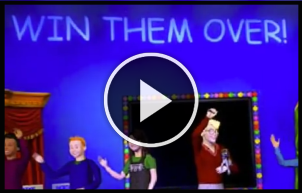
“Win Them Over!”
DESCRIPTIVE WRITING
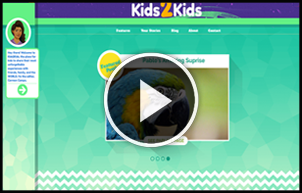
Descriptive Writing Game

Descriptive Writing

“Sharing Personal Experiences”
Full interactive game, personalized learning.
Teachers can shift time from whole-class instruction to personalized learning. • While some students are occupied with learning games, the teacher can coach small groups or individuals. • Grade 2-3 lessons are available for Grade 4-5 students who are working at lower grade levels.
Saves Teacher Time
Teacher time is saved in planning, instruction, and evaluation.
♦ Detailed lesson plans include learning outcomes and step-by-step strategies. ♦ The basic concepts of each composition lesson provide templates for additional lessons on the same genre. ♦ Games are self-scoring. ♦ Checklists and “how to” videos enable students to revise and edit their own compositions.
Teacher Support Materials
Teachers may draw upon a rich array of learning materials, including mini-lessons, graphic organizers, and short video tutorials.
Teacher guide: Persuasive Writing
Teacher guide: Descriptive Writing
User-Tested
Information coming soon, pending results of classroom tests.
Program Highlights
Common core alignment.

Game-Based Learning
The eWriting for Kids! program is in the vanguard of a new era deploying game-based lessons to help teachers deliver highly engaging interactive writing lessons within the actual time available, and provide online lessons anytime, anywhere.
Lesson Design
Grades 2 - 3 lessons, support this non-profit organization by funding additional interactive learning games., what people are saying. . ..
Read real reviews and comments about eWriting For Kids!
This is an AMAZING Game! I love it (Win Them Over!) and so do the children I have tried it with. Stephen R. - United Kingdom
A fun 3D game (Win Them Over!) used to teach writing. The game is engaging and innovative. Strengths: Innovative, teaches writing (which is rare to find) Free, Instructor Resource/Support provided. Self-paced, can be used in formal and informal settings. I think it is great that while everyone is developing STEM teaching games, this game realizes the importance of writing. I have seen a decline in writing skills among students and I feel this game is a great way to tackle issues such as poor communication skills in our youth. Judge feedback, SIIA CODiE Awards 2017
The value is nearly immeasurable. I had a more than a few kids come up and say either ``Hey, that was (writing) actually fun!`` or ``I like writing when I can write about what I want.`` The best feature was allowing the children to discover their strengths and weaknesses regarding Descriptive Writing. It improves grammar, reading skills, and of course allows the kids to further expand on their imagination and creativity. * Comments after 16 Girls and Boys Tested ``Sharing Personal Experiences``. Sean W. - Youth Development Professional Boys and Girls Club
- Science Games
- Language Arts Games
- Social Studies Games
- Music Games
- Essays, Reports
- Safety Games
- Free Powerpoints
Persuasive Writing Free Games & Activities for Kids
Argument Wars Game
Quandary Game - cartoon, set in space, the art of persuasion
The Republia Times Game - quick and challenging
The Writing Game - Persuasion, interactive (flash)
5 online games that teach the art of persuasion
For Teachers: Persuasion Lesson Plans and Handouts, Student Activities
For teachers, classroom activity: The Game of Persuasion
TV Game Show - The Power of Persuasion
Can you convince me?
Writing Grammar Reading Language Arts
Free Presentations in PowerPoint format
- Skip to Nav
- Skip to Main
- Skip to Footer

5 Online Games That Teach Kids the Art of Persuasion
Please try again
By Tanner Higgin, Graphite
If there's one thing that games can teach really well, it's systems thinking. Getting good at a game like Portal , for instance, means learning its physics engine. When the game's over, it's only natural to draw comparisons between how things move, fall, and interact in the game and physical worlds. Similarly, building nations in Civilization exposes players to complex political, social and cultural relationships they can see reflected in global history. These examples are, admittedly, a bit old hat. Sure -- games can teach gravity or supply and demand, but can they show us how to build a good argument?
The following five games do just that by modeling the work of argumentation. Best of all, they approach the subject critically, showing the myriad uses for persuasion and how it's always political.
1. Quandary
Set on a colony somewhere out in space, Quandary tasks the player with settling disputes and solving problems by building sound arguments for one side or the other. Players tackle tough issues, sort fact from opinion, gather support, and try to make the best decision for the community even though there's no clear right or wrong answer.
2. Citizen Science
Good argumentation isn't just important to the humanities. Citizen Science demonstrates how effective persuasive skills help scientists better inform policy and make positive change in the world. Much like Quandary, players must gather, evaluate, and use evidence to sway public opinion to the best position.
3. Argument Wars
The stakes are high in Argument Wars. Players engage in debate-style combat over real Supreme Court cases. Like other games on this list, there's a healthy focus on argumentative structure and sound support, but players must align their arguments with the U.S. Constitution. After each case, players get to dig into the case's history, finding out how events actually played out.
4. The Republia Times
The Republia Times might be the most stripped down game on this list, but that doesn't mean it lacks punch. It only takes 10 minutes to play and has a super simple concept –- players play the role of an editor in charge of curating a newspaper's front page. Yet it does a fantastic job of communicating the political nature of any given system. And by focusing on editing rather than writing, players see how persuasion takes different forms.
5. Papers, Please
A follow-up of sorts to The Republia Times , Papers, Please puts players in the shoes of an immigration officer manning the border of a fictional communist country. To decide who is allowed in, players must build evidential arguments. They evaluate peoples' documents, question them, and try to find the evidence needed to justify denial or admittance. It's a stressful, grim experience full of heart wrenching decisions that show how ethics and morals are often at odds.
Tanner Higgin is Senior Manager, Education Content, at Common Sense Media, creator of Graphite ™ , a free service for educators in search of the best apps, games, and websites rated for learning. This post is one in a series collaboration. Games included here have received high ratings on Graphite by educators and by the editorial staff at Common Sense Media. Go to Graphite to read full reviews of games and how teachers use them for learning in class.
Persuasion Map
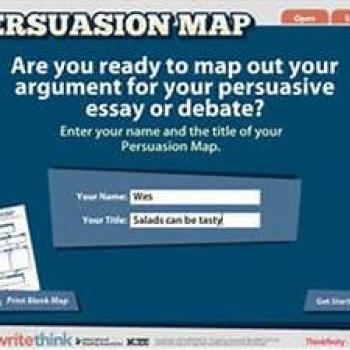
About this Interactive
Related resources.
The Persuasion Map is an interactive graphic organizer that enables students to map out their arguments for a persuasive essay or debate. Students begin by determining their goal or thesis. They then identify three reasons to support their argument, and three facts or examples to validate each reason. The map graphic in the upper right-hand corner allows students to move around the map, instead of having to work in a linear fashion. The finished map can be saved, e-mailed, or printed.
- Student Interactives
- Strategy Guides
- Calendar Activities
- Lesson Plans
The Essay Map is an interactive graphic organizer that enables students to organize and outline their ideas for an informational, definitional, or descriptive essay.
This Strategy Guide describes the processes involved in composing and producing audio files that are published online as podcasts.
This strategy guide explains the writing process and offers practical methods for applying it in your classroom to help students become proficient writers.
Through a classroom game and resource handouts, students learn about the techniques used in persuasive oral arguments and apply them to independent persuasive writing activities.
Students analyze rhetorical strategies in online editorials, building knowledge of strategies and awareness of local and national issues. This lesson teaches students connections between subject, writer, and audience and how rhetorical strategies are used in everyday writing.
Students examine books, selected from the American Library Association Challenged/Banned Books list, and write persuasive pieces expressing their views about what should be done with the books at their school.
Students will research a local issue, and then write letters to two different audiences, asking readers to take a related action or adopt a specific position on the issue.
- Print this resource
Explore Resources by Grade
- Kindergarten K
- For Schools
- For Teachers
- Teacher Hub
- Free resources
- For Seven Steppers
- NAPLAN Writing Success
- Free writing resources
- About Seven Steps
- Seven Steps and the Curriculum
- What are the Seven Steps?
- Success Stories
- Press & Media
- Seven Steps Impact Report
- [FREE] Try Sizzling Starts
- Narrative Writing
- Persuasive Writing
- Informative Writing
No products in the cart.

- Your password must be 8 or more characters, including at least 1 upper case letter, 1 lower case letter and 1 number.
- Add new school
Persuasive Lesson Plans and Activities

Explore ready-made resources and discover how to teach the key concepts behind each Step.
Lesson plans.
- This series of sample lesson plans demonstrates how to teach the Seven Steps activities using the explicit teaching model – I Do, We Do, You Do.
- Each lesson plan includes relevant links to the Australian Curriculum and NAPLAN marking criteria, plus a learning intention and success criteria to assist with planning and assessment.
- Become a Teacher Hub member to access the full range of Seven Steps Lesson Plans.
Think First, Write Second
STEP Step 1: Plan for Success PURPOSE Teach RESOURCE TYPE Lesson plan YEAR 3–6 RELATED
- Learn how to brainstorm and select great ideas for a persuasive text.
- Students work in groups to come up with several arguments for and against a topic.
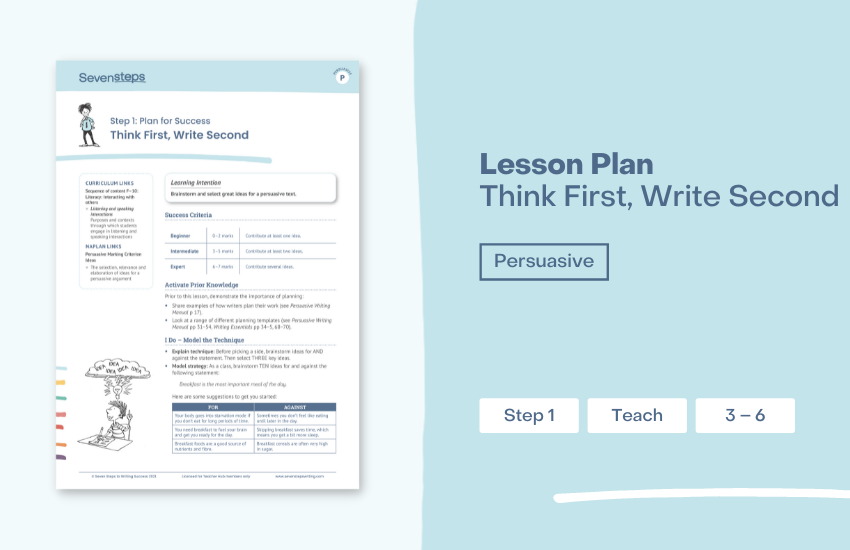
- These templates promote creative thinking and encourage students to have fun with the Seven Steps.
- We have a range of templates available for students of all ages and ability levels (see Teacher Hub for more). Students can write or draw on the templates; many are editable PDFs that can be used electronically.
For and Against Topic Brainstorm
STEP Step 1: Plan for Success PURPOSE Apply RESOURCE TYPE Template YEAR F–10
- This editable template is left blank to fill with a ‘for and against’ topic of your choice.
- Teach students to brainstorm ideas for and against a topic before picking a side
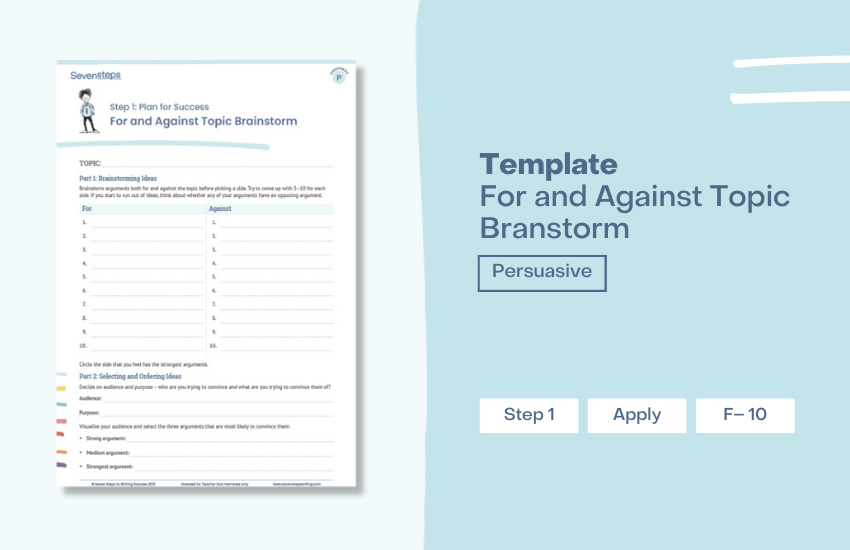
Planning tools
- Need tips on how to implement the Seven Steps? We have a selection of planning resources on Teacher Hub to help you with ideas and inspiration.
Writing Improvement Agenda
STEP All Steps PURPOSE Teach RESOURCE TYPE Planning YEAR F–10 RELATED Bucking the trend with the Seven Steps
- A sample Term 4 planning document from Allenstown State School in Queensland.
- Amalgamates the NAPLAN marking criteria with the Seven Steps in a fortnightly scheme of work.
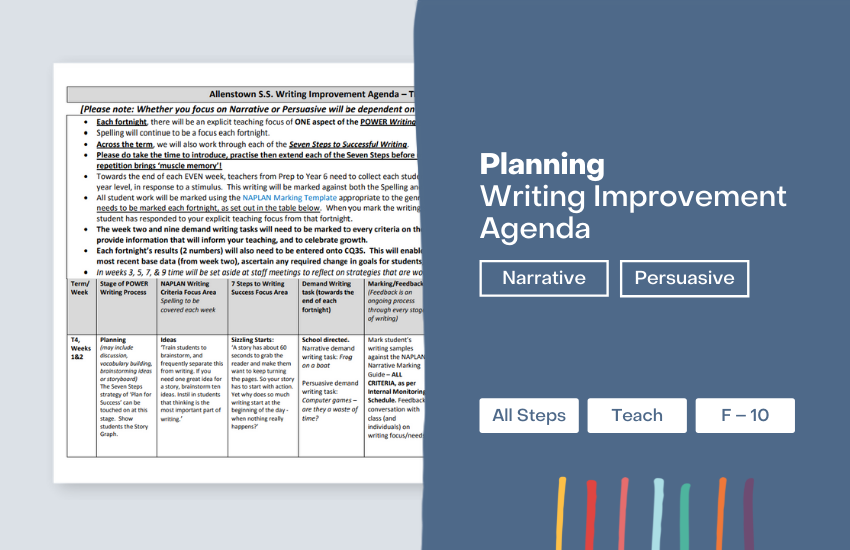
More persuasive resources
Explore more classroom resources and make persuasive writing fun with the Seven Steps!

Writing samples and exemplars
Discover the difference Seven Steps can make with these student writing samples. We also have ‘real world’ exemplars – discover how professional authors use the Seven Steps in narrative texts.
Picture writing prompts
These visual prompts offer fun and quick writing practice to develop your students’ writing skills, one Step at a time.
Other text types
Mastered persuasive writing? Explore more Seven Steps resources for narrative and informative writing!
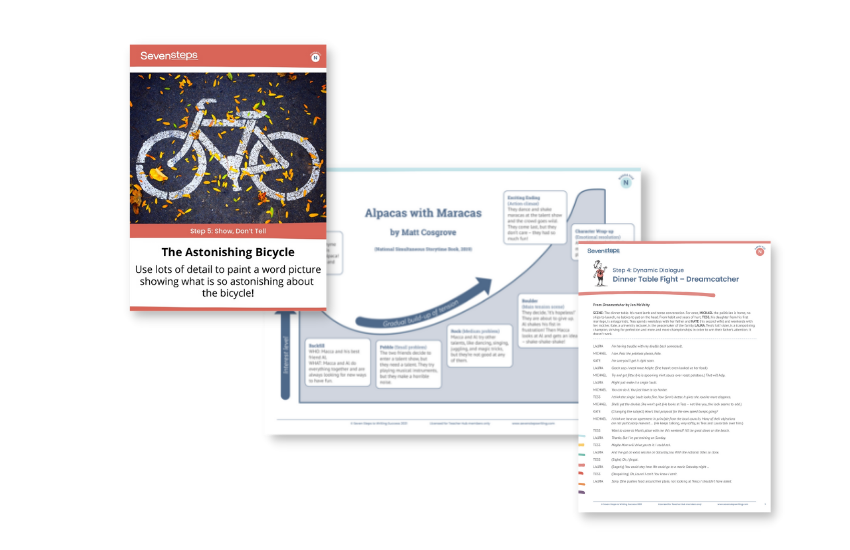
Narrative writing
Lesson plans and activities to help your students create epic tales and become great storytellers.
Informative writing
Lesson plans and activities to help your students write engaging informative texts that bring facts to life.
Persuasive Writing Course
Step-by-Step guide to teaching the Seven Steps for persuasive writing.
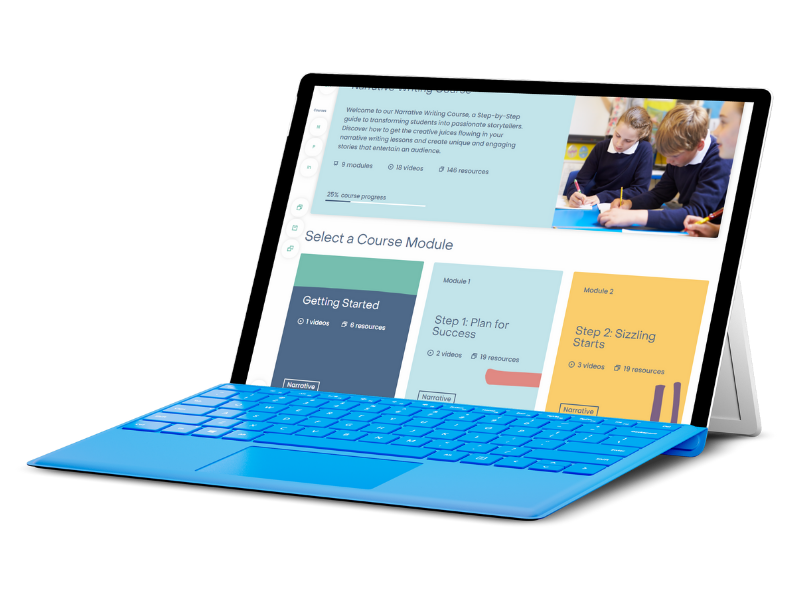
- Chess (Gr. 1-4)
- TV (Gr. 1-4)
- Metal Detectors (Gr. 2-6)
- Tetris (Gr. 2-6)
- Seat Belts (Gr. 2-6)
- The Coliseum (Gr. 2-6)
- The Pony Express (Gr. 2-6)
- Wintertime (Gr. 2-6)
- Reading (Gr. 3-7)
- Black Friday (Gr. 3-7)
- Hummingbirds (Gr. 3-7)
- Worst Game Ever? (Gr. 4-8)
- Carnivorous Plants (Gr. 4-8)
- Google (Gr. 4-8)
- Honey Badgers (Gr. 4-8)
- Hyperinflation (Gr. 4-8)
- Koko (Gr. 4-8)
- Mongooses (Gr. 5-9)
- Trampolines (Gr. 5-9)
- Garbage (Gr. 5-9)
- Maginot Line (Gr. 5-9)
- Asian Carp (Gr. 5-9)
- Tale of Two Countries (Gr. 6-10)
- Kevlar (Gr. 7-10)
- Tigers (Gr. 7-11)
- Statue of Liberty (Gr. 8-10)
- Submarines (Gr. 8-12)
- Castles (Gr. 9-13)
- Gutenberg (Gr. 9-13)
- Author's Purpose Practice 1
- Author's Purpose Practice 2
- Author's Purpose Practice 3
- Fact and Opinion Practice 1
- Fact and Opinion Practice 2
- Fact and Opinion Practice 3
- Idioms Practice Test 1
- Idioms Practice Test 2
- Figurative Language Practice 1
- Figurative Language Practice 2
- Figurative Language Practice 3
- Figurative Language Practice 4
- Figurative Language Practice 5
- Figurative Language Practice 6
- Figurative Language Practice 7
- Figurative Language Practice 8
- Figurative Language Practice 9
- Figurative Language of Edgar Allan Poe
- Figurative Language of O. Henry
- Figurative Language of Shakespeare
- Genre Practice 1
- Genre Practice 2
- Genre Practice 3
- Genre Practice 4
- Genre Practice 5
- Genre Practice 6
- Genre Practice 7
- Genre Practice 8
- Genre Practice 9
- Genre Practice 10
- Irony Practice 1
- Irony Practice 2
- Irony Practice 3
- Making Inferences Practice 1
- Making Inferences Practice 2
- Making Inferences Practice 3
- Making Inferences Practice 4
- Making Inferences Practice 5
- Main Idea Practice 1
- Main Idea Practice 2
- Point of View Practice 1
- Point of View Practice 2
- Text Structure Practice 1
- Text Structure Practice 2
- Text Structure Practice 3
- Text Structure Practice 4
- Text Structure Practice 5
- Story Structure Practice 1
- Story Structure Practice 2
- Story Structure Practice 3
- Author's Purpose
- Characterizations
- Context Clues
- Fact and Opinion
- Figurative Language
- Grammar and Language Arts
- Poetic Devices
- Point of View
- Predictions
- Reading Comprehension
- Story Structure
- Summarizing
- Text Structure
- Character Traits
- Common Core Aligned Unit Plans
- Teacher Point of View
- Teaching Theme
- Patterns of Organization
- Project Ideas
- Reading Activities
- How to Write Narrative Essays
- How to Write Persuasive Essays
- Narrative Essay Assignments
- Narrative Essay Topics
- Persuasive Essay Topics
- Research Paper Topics
- Rubrics for Writing Assignments
- Learn About Sentence Structure
- Grammar Worksheets
- Noun Worksheets
- Parts of Speech Worksheets
- Punctuation Worksheets
- Sentence Structure Worksheets
- Verbs and Gerunds
- Examples of Allitertion
- Examples of Hyperbole
- Examples of Onomatopoeia
- Examples of Metaphor
- Examples of Personification
- Examples of Simile
- Figurative Language Activities
- Figurative Language Examples
- Figurative Language Poems
- Figurative Language Worksheets
- Learn About Figurative Language
- Learn About Poetic Devices
- Idiom Worksheets
- Online Figurative Language Tests
- Onomatopoeia Worksheets
- Personification Worksheets
- Poetic Devices Activities
- Poetic Devices Worksheets
- About This Site
- Privacy Policy
- Terms of Use
- Understanding CCSS Standards
- What's New?
Ereading Worksheets
Free reading worksheets, activities, and lesson plans., site navigation.
- Learn About Author’s Purpose
- Author’s Purpose Quizzes
- Character Types Worksheets and Lessons
- List of Character Traits
- Differentiated Reading Instruction Worksheets and Activities
- Fact and Opinion Worksheets
- Irony Worksheets
- Animal Farm Worksheets
- Literary Conflicts Lesson and Review
- New Home Page Test
- Lord of the Flies Chapter 2 Worksheet
- Lord of the Flies Chapter 5 Worksheet
- Lord of the Flies Chapter 6 Worksheet
- Lord of the Flies Chapter 10 Worksheet
- Narrative of the Life of Frederick Douglass
- Sister Carrie
- The Count of Monte Cristo
- The Odyssey
- The War of the Worlds
- The Wizard of Oz
- Mood Worksheets
- Context Clues Worksheets
- Inferences Worksheets
- Main Idea Worksheets
- Making Predictions Worksheets
- Nonfiction Passages and Functional Texts
- Setting Worksheets
- Summarizing Worksheets and Activities
- Short Stories with Questions
- Story Structure Activities
- Story Structure Worksheets
- Tone Worksheets
- Types of Conflict Worksheets
- Reading Games
- Figurative Language Poems with Questions
- Hyperbole and Understatement Worksheets
- Simile and Metaphor Worksheets
- Simile Worksheets
- Hyperbole Examples
- Metaphor Examples
- Personification Examples
- Simile Examples
- Understatement Examples
- Idiom Worksheets and Tests
- Poetic Devices Worksheets & Activities
- Alliteration Examples
- Allusion Examples
- Onomatopoeia Examples
- Onomatopoeia Worksheets and Activities
- Genre Worksheets
- Genre Activities
- Capitalization Worksheets, Lessons, and Tests
- Contractions Worksheets and Activities
- Double Negative Worksheets
- Homophones & Word Choice Worksheets
- ‘Was’ or ‘Were’
- Simple Subjects & Predicates Worksheets
- Subjects, Predicates, and Objects
- Clauses and Phrases
- Type of Sentences Worksheets
- Sentence Structure Activities
- Comma Worksheets and Activities
- Semicolon Worksheets
- End Mark Worksheets
- Noun Worksheets, Lessons, and Tests
- Verb Worksheets and Activities
- Pronoun Worksheets, Lessons, and Tests
- Adverbs & Adjectives Worksheets, Lessons, & Tests
- Preposition Worksheets and Activities
- Conjunctions Worksheets and Activities
- Interjections Worksheets
- Parts of Speech Activities
- Verb Tense Activities
- Past Tense Worksheets
- Present Tense Worksheets
- Future Tense Worksheets
- Point of View Activities
- Point of View Worksheets
- Teaching Point of View
- Cause and Effect Example Paragraphs
- Chronological Order
- Compare and Contrast
- Order of Importance
- Problem and Solution
- Text Structure Worksheets
- Text Structure Activities
- Essay Writing Rubrics
- Narrative Essay Topics and Story Ideas
- Narrative Essay Worksheets & Writing Assignments
- Persuasive Essay and Speech Topics
Persuasive Essay Worksheets & Activities
- Writing Narrative Essays and Short Stories
- Writing Persuasive Essays
- All Reading Worksheets
- Understanding Common Core State Standards
- Remote Learning Resources for Covid-19 School Closures
- What’s New?
- Ereading Worksheets | Legacy Versions
- Online Figurative Language Practice
- Online Genre Practice Tests
- Online Point of View Practice Tests
- 62 School Project Ideas
- 2nd Grade Reading Worksheets
- 3rd Grade Reading Worksheets
- 4th Grade Reading Worksheets
- 5th Grade Reading Worksheets
- 6th Grade Reading Worksheets
- 7th Grade Reading Worksheets
- 8th Grade Reading Worksheets
- 9th Grade Reading Worksheets
- 10th Grade Reading Worksheets
- Membership Billing
- Membership Cancel
- Membership Checkout
- Membership Confirmation
- Membership Invoice
- Membership Levels
- Your Profile

Want Updates?
84 comments.
Thank you so much. This has truly helped me in my exams and throughout the beneficial journey of my school year.
Ellen Davis
How will I be able to check my work, when I print it out to work on them? Where are the answers?
I guess it depends on what you are working on. On what are you working?
Kareema Coles
Ummm the pdf version is not working…is the link still valid?
Which link?
This is an amazing website with fabulous ideas and printable ready to go lessons!!! Thank you so much! I wish I could meet you!!!
Thank you very much for this amazing resource and great ideas. They are extremely comprehensive and well designed. Thank you very much for your kind consideration and not adding a Price-tag to your valuable resources. Highly appreciated.
Sandra Conner
Thank you so much for sharing your knowledge and your work with us. As teachers, we are always in need of fresh material. I teach college level creative writing classes, and your worksheets help my students. Sometimes I change the essay topics to fit their particular age group or interest, but having these examples laid out for us and made available for use in our classrooms is wonderful.
Lifesaver! Thank you for the great ideas and guidance. I am a new teacher, and finding this site has made a true turn around in my instruction. Thank you, thank you, thank you!!!
Thank you for these great step by step resources
Macca Malbrán
Despite all the negative comments above, you should keep up for the ones (like me) who are absolutely grateful for these material.
Thanks for sharing! Best.
I give this website 3stares only for the info but in general 1star
I give your comment 0 stars because your position lacks support or evidence of any kind. Complete some of these worksheets and begin your argument again.
that’s stupid from where do u get the worksheets
I wrote them.
I did not see any activities that required the student to write an entire essay.
https://www.ereadingworksheets.com/writing/persuasive-essay-topics/
Lamar Mohamed
Thank you for this information! They helped me in my exam so much!
These are fantastic resources! Thank you so much for sharing them. I only wish I had found them earlier in the school year!
There’s always next year…
Thank you so much for all you do for teachers. I love an use practically everything on your Website!
That’s awesome. Thanks for visiting my website.
I really like this website
Shenard McDougal
How can a teacher get the answers to the worksheets?
Leave a Reply Cancel reply
Your email address will not be published. Required fields are marked *
Subscribe Now
Popular content.
- Author's Purpose Worksheets
- Characterization Worksheets
- Common Core Lesson and Unit Plans
- Online Reading Practice Tests
- Plot Worksheets
- Reading Comprehension Worksheets
- Summary Worksheets
- Theme Worksheets
New and Updated Pages
- Capitalization Worksheets
- Contractions Worksheets
- Double Negatives Worksheets
- Homophones & Word Choice Worksheets
BECOME A MEMBER!

5 Top Persuasive Writing Lesson Plans for Students and Teachers
The purpose of any persuasive writing text is to persuade the reader of a particular point of view or to take a specific course of action. Persuasive texts come in many different forms, including, but not limited to, essays, editorials, letters, advertisements, and reviews. While persuasive texts come in many shapes and sizes, they all share standard features.
Persuasive texts employ a wide variety of different rhetorical strategies and techniques to achieve their ends. For example, they’ll use emotive language and rhetorical questions. Images are sometimes used to entice or appeal to the reader or viewer.
Advertising is one key form of persuasive writing . It makes vigorous use of all the tools in the persuasive writing toolbox as it strives to sell goods or services to the reader.
In this article, you’ll learn how to take your students from reluctant salespersons to master marketers in a lightning-fast five days.
Students will first learn how the various persuasive strategies work before incorporating them into their advertisements. We have comprehensive guides to persuasive writing and advertisements you should explore also.
So, let’s get started!

Persuasive Writing Lesson Plan 1: Identify the Key Features of Adverts
Before your students will be able to produce their own well-written advertisements, they’ll need to be well-versed in all the tricks up the skilful salesperson’s sleeves.
One of the most productive ways for students to do this is through reverse engineering.
Organize your students into small groups or pairs and distribute print advertisements gleaned from various sources such as magazines, newspapers, and posters. You could also show projections of some sample advertisements projected onto the whiteboard to facilitate this exercise.
Now, ask the students to examine the advertisements and answer the following question:
What techniques do the advertisers use to get our attention?
Challenge the students to go beyond the pretty obvious features of advertisements, e.g. branding, slogans, and testimonials, to also look at more subtle techniques such as the use and interplay of images and various other effects created by language choices and figurative devices.
When the students have finished their discussions, give them feedback as a whole class and use their responses to compile a master list of the various features they have identified.
Some features suggested by the class might include:
- Emotive language
- Exaggeration
- Appealing adjectives
- Powerful verbs
- Strong adverbs
- Contact details
- Alliteration
- Rhetorical questions
- Testimonials
Once you have compiled a master list of persuasive strategies and techniques used in advertising, these can handily be turned into checklists that the students can use when producing their own advertisements later.
Persuasive Writing Lesson Plan 2: Analyze an Advert
Now, the students have a solid understanding of the different features of advertisements and a checklist to work from; it’s time for them to analyze an advert in more detail.
Not only will this prove a valuable exercise to help prepare your students for producing their own advertisements later in the week, but it will also serve as an excellent task to improve your students’ media literacy skills. It may even help to innoculate them from media manipulation in the future.
To get started on their advertisement analysis, they’ll need to source a suitable advertisement to look at in detail.
Older and higher-ability students may be fit to make their own choices regarding which advertisement to analyze. If this is the case, perhaps they can choose an advert for a product they like or a product or service in a category that interests them greatly.
Allowing your students some say in the ads they analyze will help fuel their interest and enthusiasm when creating their own advertisements later.
However, it might be best to choose a sample advertisement for younger students and those of lower ability – or at least offer a pre-vetted, limited choice. They will most likely have enough to contend with already!
When students have a suitable advertisement to hand, please encourage them to use their checklist from yesterday’s lesson to explore how the ad works. The students should then write a paragraph identifying the various techniques used in the advertisement and their effect.
Challenge the students to write another paragraph or two, considering what makes the advertisement work – or not, as the case may be. Ask them to consider where the advertisement could be improved. Could the slogan be catchier? How about the logo? Does it convey the brand’s identity appropriately? Are the images used in the advertisement optimal?
When the students have finished their paragraphs, they can display their advert and their analysis and share their thoughts with the class.
Persuasive Writing Lesson Plan 3: Plan an Advertisement
At this stage, your students should have a good understanding of many of the main features of advertisements and had plenty of opportunities to see examples of these in action. Now it’s time for them to begin to plan for writing their own advertisements. Here are some areas for your students to think about when starting the planning process.
The Purpose and Audience
Like any other writing type, students will need to identify both the purpose and the audience for their advertisements bef ore putting pen to paper.
The purpose of any advertisement is to sell goods or services. Precisely what goods or services are being sold is the first question that needs to be answered.
Students might like to focus on the goods or services advertised in the adverts they’ve been exploring over the previous two days. Or, if they prefer, they might like to choose something new entirely.
Once they’ve chosen what they’re selling, students will need to identify who they will sell it to. Scattershot advertisements that attempt to sell to everyone often end up selling to no one.
One effective way to help focus an advert is to define a ‘buyer persona’ first. This is a profile of the hypothetical buyer who the ad will target.
Students can consider the following characteristics to help them develop their buyer’s persona:
- Education level
- Marital status
- Likes/Dislikes
- Who they trust
- What they read/watch
The Brand Name
The next stage is for the student to decide on a name for their company. This should usually be something relatively short and memorable, and appealing to the target audience.
Generally, the student will need to come up with at least four or five ideas first. They can then choose the best.
It can be a helpful practice for the student to look at the brand names for companies selling similar goods and services. A little internet research will be beneficial here.
Now it’s time for students to jot down ideas for their brand’s slogan. Slogans are short and punchy phrases that help make brands more memorable for customers.
Slogans often employ literary devices such as alliteration, puns, or rhyme. They don’t always have to be the most meaningful things in the world; it’s more important that they’re memorable. Think Nike’s Just to Do It or McDonald’s I’m Lovin’ It – not the most meaning-rich phrases in the world but instantly recognizable!
The Body Copy
This part of the advertisement will contain the bulk of the writing. It’s where the students will get to use the various techniques and strategies they’ve explored in the previous activities.
Despite containing most of the ad’s text, advertising copy is usually concise and to the point. Student’s should strive to get the main points across in the fewest words possible. Nothing turns readers off faster than impenetrable walls of text.
To help organize the text, students may use bullet points and subheadings. They should be sure to include any specific information or specifications that they want the reader to know about the product or service.
The language chosen should also be appropriate for speaking to the audience that they have defined earlier.
The Call to Action
The Call to Action – commonly referred to as the CTA , usually comes at the end of an advertisement.
The CTA typically comprises a few sentences that invite the reader to take a particular course of action. Normally, to buy the advertised goods or service.
However, not all CTAs focus on getting the reader to make an immediate purchase. Some, for example, aim to get the reader to provide their contact details so they can be sold to later.
Students need to first define what their Call to Action will invite readers to do. They will then need to choose a strong imperative that will call on the reader to take that specific action. Commonly used verbs that urge readers to take action include subscribe, join, buy, etc.
The CTA must be clear and specific; the reader should be in no doubt about what the advertisement is asking them to do.
Often, the CTA will create a sense of urgency by limiting special offers by time.
As part of the planning process, students should use some of their time in today’s session to think about and make some notes on options they might like to include in the final drafts of their Call to Action.
Persuasive Writing Lesson Plan 4: Create the Advertisement
Day 4, already! This is the day students will try to bring all the elements together. They’ll work to complete their advertisements by the end of today’s session.
You may like to have the students collaborating to produce their ads or working individually. Either way, reinforce the importance of attention to detail in their work.
The main focus for persuasive texts of any kind, advertisements included, shouldn’t be length but, instead, it should be on how effectively it persuades the reader to take the desired action.
Students should incorporate their planning from yesterday and refer to their checklists as they create. As precise language is so essential to effective marketing, encourage students to use thesauruses to help them find just the right word for their copy.
When students have had a chance to draft their advertisements, they can then get into small groups and compare their work. This is an opportunity for students to provide each other with constructive criticism.
They can use their checklists as a basis to provide this criticism. Students can then revise their advertisements in light of the advice they’ve received in their groups.
Persuasive Writing Lesson Plan 5: Further Practice in the Art of Persuasion
In the process of comparing their work with each other, with reference to the criteria they’ve worked on earlier in the week, students will no doubt identify areas they are strong in and other areas where they are weaker.
Day 5’s activities should offer students an opportunity to practice those areas identified as needing further work to bring them up to par.
For example, students can practice their persuasion skills by moving their focus from printed ads to other types of marketing endeavours that utilise the arts of persuasion.
Where students struggled to employ literary devices in their advertising copy, they may benefit from creating a radio jingle or radio ad for their product or service. As this type of ad can contain no visual imagery to support, writing a radio jingle or ad will force the student to pay particular attention to verbal imagery, rhyme, alliteration, etc.
If the testimonials used in the first advertisement were unconvincing, perhaps the student will benefit from isolating this strategy to focus exclusively on effective testimonial writing. They should spend some time researching testimonials and how to write them effectively.
For example, testimonials should usually be:
- Short and to the point
- Conversational in tone
- Authentic (use a name, photo, job title, etc.)
- Specific about the benefits
- Directed at overcoming objections.
Once students have a good handle on how these work, they should put their new-found knowledge into practice and get writing as soon as possible.
This research-then-practice model can help the student improve in whatever particular area of persuasion that needs work – as identified in yesterday’s activity.
Getting good at persuasive writing demands our students to develop their knowledge and abilities with a broad range of skills and strategies.
Advertising copy is a highly concentrated form of persuasive writing and, therefore, an excellent means for our students to gain lots of practice in a short space of time.
And, as the saying goes, a good start is half the work, so set your class of creative copywriters on the road to marketing mastery today!
ARTICLES RELATED TO PERSUASIVE WRITING LESSON PLANS

How to Write Perfect Persuasive Essays in 5 Simple Steps

Top 5 Persuasive Writing Techniques for Students

23 Persuasive writing Topics for High School students

How to Write an Advertisement: A Complete Guide for Students and Teachers
Rebecca: The Irish Teacher
Former expat, who returned to ireland with a passion for quality, purposeful lessons, ideas for persuasive writing.
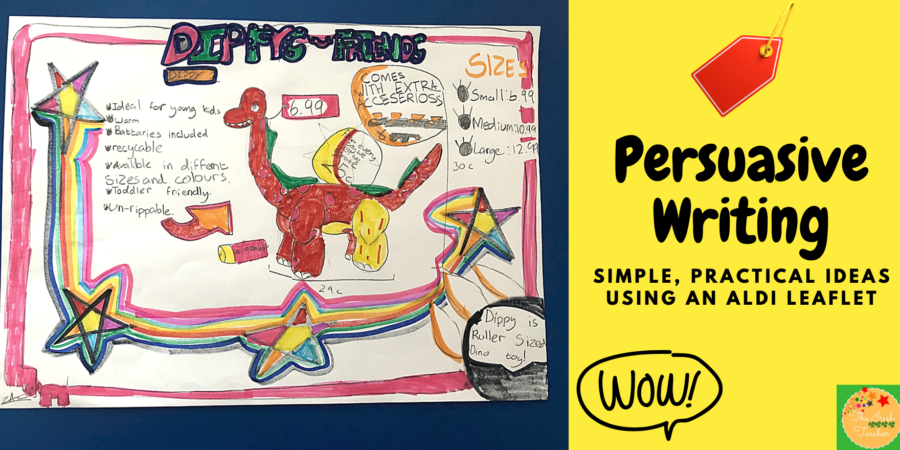
For the last two weeks, we have engaged with the genre of persuasive writing. Personally, I find that since returning to school after distance learning, the children are not as enthusiastic about writing.
With that in mind, I wanted to motivate them to write, while covering persuasive writing at the same time. I decided to focus on persuasive adverts as it was a nice introduction to this genre and allowed for more creativity and fun in my opinion.
Links to The Book Depository are affiliate links.
Planning for Persuasive Writing
As always when I start a new genre, I took out my trusty copy of Talk for Writing to see if there were any key ideas that I could use to inform my planning.
View this post on Instagram A post shared by Rebecca The Irish Teacher ☘️ (@rebecca.the.irish.teacher)
Before I began planning, I then knew that I wanted children to reach these end goals after two weeks:
- Audience- to understand WHO their advertisement was for.
- Weasel words- to use persuasive adjectives and descriptions to persuade their reader.
- Author’s choice- to comment on the effect of shapes, colours and fonts used to persuade the reader and apply this when creating their own advertisement.
- Presentation- to think about how to make the key information stand out to their reader.
- Topic specific vocabulary- to ensure the children had the vocabulary needed to sell their product successfully.
Once decided on the end goals of this unit, I was able to plan my daily lessons accordingly.
With each genre, it is so important to have a variety of texts for children to pick apart and take ideas from. While I normally take from my library , with this genre, I wanted children to get a sense of real-life purpose with their writing this week.
We physically cut apart and dissected an Aldi leaflet and took SO much inspiration from it. What better than a real-life example of persuasive writing in action. But also- NO PREP!
They are free in all Aldi stores and FULL of useful lessons (Maths too).

Setting children up for success to write a persuasive advertisement
Below I’ll list some activities which we did in order to build the children up to write a successful persuasive advertisement.
Gauge their understanding of oral persuasion
I modelled how to persuade the children to do their Maths work. I showed them how to use flattery (but not too much) and inform them of how it would be a good choice FOR THEM. We had to have lots of discussions about how and why threats can’t be used too.
Then, I wrote 25 topics on lollipop sticks and asked children to practise persuading the others on their table, using a similar technique. This was a good way for me to assess where children needed help with persuasive writing in the coming weeks.
Highlight “weasel words” in the Aldi leaflet
In mixed ability pairs, allow children to use a highlighter or marker to underline the words that would catch the reader’s eye. For example: quick absorbing and enriched with anti-oxidants.
Allow them to make a list in their copies to refer back to. Not all weasel words will be relevant to their product, but they will be able to choose themselves when it comes to that.

Sort positive and negative adjectives
This was done as a starter for a lesson. Children worked in pairs to discuss and decided which adjective went into which category. This increased their awareness of the importance of choosing the correct adjective and the impact that it would have on their product’s sales.

Turn a “negative” paragraph into a “positive” paragraph
Display the “negative” paragraph on the board and highlight all of the adjectives that make this paragraph sound negative and unappealing. As a class, make a list of appropriate words that could replace them to make this paragraph much more appealing and persuasive.
End this lesson by discussing the importance of choosing effective adjectives and descriptions for a product.

Create a sample, “super” advert
This lesson was very effective and useful to build on prior to the children’s writing of their own advertisement.
Children were asked to create an advertisement for a toy dinosaur in pairs on sugar paper. They could cut out any “weasel words” or price tags from the Aldi leaflet that they felt stood out.
This really made for great discussion on which price tags or slogans caught their eye and why. It also led to a discussion on how many eye-catching phrases were too much, as it would overwhelm the reader.
Bullet points were collectively chosen too to portray the information, as shoppers don’t have time to read paragraphs of information. They want it quickly and clearly.
Create a list of “weasel words” that could be used for our product
As mentioned before, we were building up to create an advertisement for a dinosaur toy. We were covering dinosaurs in guided reading, so I figured it made sense to link the two. Make the product relevant to the children. They then flicked through the Aldi leaflet again, with a different hat on this time. They picked out “weasel words” that could be used to sell a dinosaur toy and jotted them down for reference later in the week.
Words such as:
- Toddler friendly
- Made from recyclable material
- Batteries included
These were words that children discussed in pairs and decided whether or not it was relevant to their toy. It was amazing to see them take ownership of their work and not rely on a list that I could have (but didn’t) provided for them.
These activities took place over the course of two weeks. By this point, I felt that my class were ready to create their own advertisement.
I gave them an A4 page each, their “super sample” that they made earlier in the week and displayed this criteria on the board. Nothing fancy at all, but it was super effective.
- Product Name
- Description (Bullet Points)
- 1 or 2 persuasive phrases.
Think about
If you look closely to the images below, you will notice that the children chose to use dinosaur footprints instead of bullet points, to catch the readers eye.
They really thought carefully about their designs, sizes, shapes and fonts.
They chose their words carefully and effectively and I couldn’t be more proud of them on the end results.
End Product
Resources for Persuasive Writing – in the past with 3rd Class/Year 4 pupils, I made use of this resource and it worked wonders.
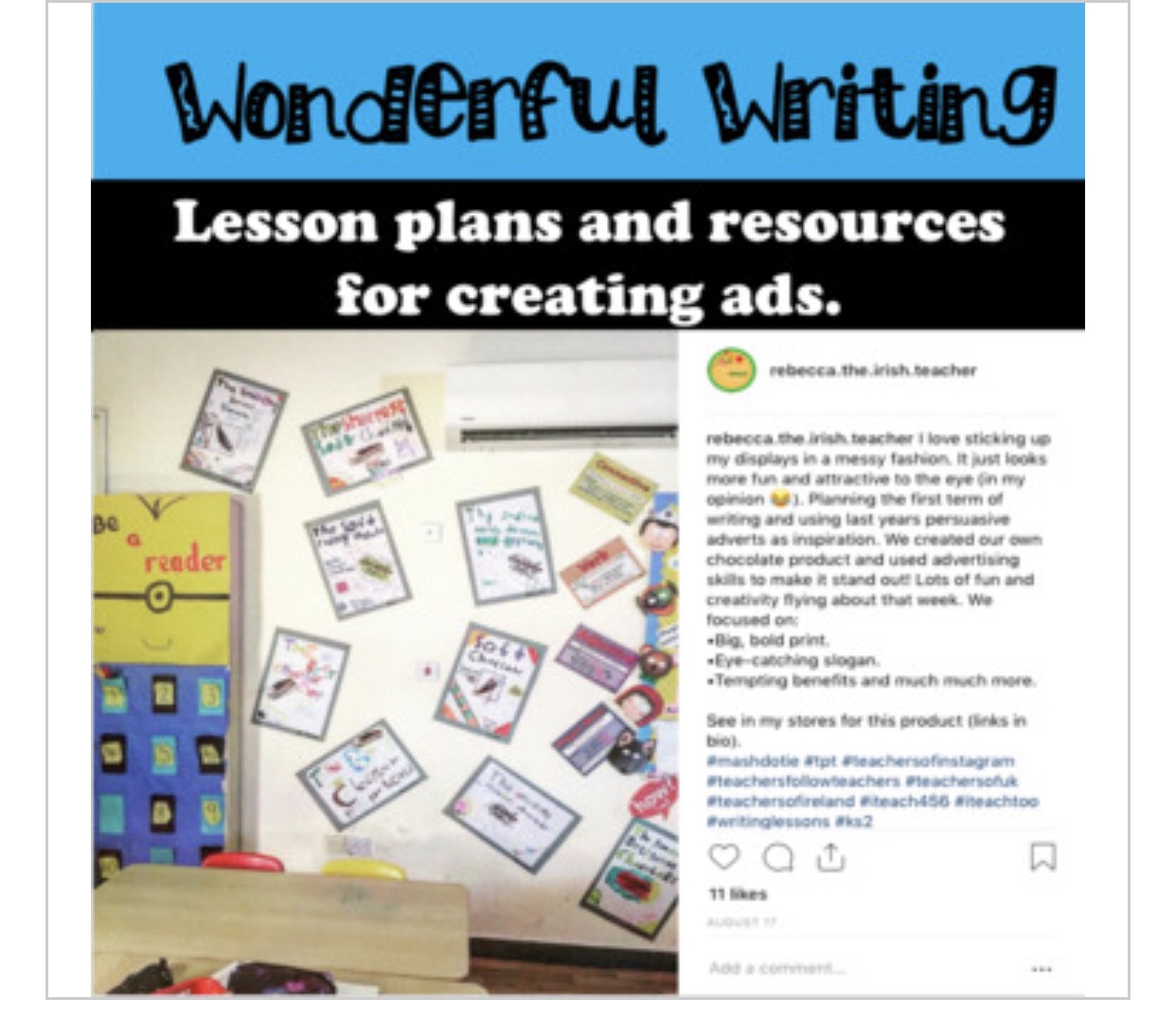
However, I felt like delving into this topic a little differently this year. Feel free to screenshot and use anything I’ve mentioned above and tag me on Instagram if you’d like too. I love seeing people using my ideas.
For a simple poetry lesson idea, click here .
For ways to promote a love of reading in the class, click here.
I hope this was helpful.

Leave a Reply Cancel reply
Your email address will not be published. Required fields are marked *
Engaging Strategies for Teaching Persuasion, Argument, and Debate
Year after year, I love teaching persuasion. I love persuading my students that persuasion is a life skill worth learning. (Because isn’t all teaching just persuading kids to listen and learn?!) Luckily, with the right mix of ethos, pathos, and logos, this is usually an easy sell to my audience of adolescents.
After all, teens love to argue…with their peers, their parents, and *gasp* their teachers. They have plenty of practice with real-life persuasion, whether it’s convincing their parents to stay out past their curfew or proposing just one extra day to work on that project. And they’re always dying to debate: which sports team is superior, why they deserve more freedom, and what’s wrong with school, society, and this world! If you’ve ever taught teenagers, you know that they have no shortage of opinions. So suffice it to say: your students are already arguers.
The challenge, of course, is helping students channel their opinions and energy into structured, academic argumentation. To do this, you’ll need high-engagement activities that match your students’ energy… not the ancient 5-paragraph persuasive essay over a subject on that random list of 100 debatable topics you found online. If we want to move students to a more sophisticated level of debate, we need to offer them student-centered, authentic, and relevant tasks to practice their persuasion.
Ready to ditch the 5-paragraph persuasive essay and engage your students in meaningful persuasion? Here are dozen different strategies for your ELA classroom.
MOCK TRIALS
Want to teach students how important it is to support your argument with evidence (and what happens when you don’t)? Ready to watch your class eagerly annotate a text and cite said evidence *without* complaints?

I wasn’t sure my students would ever see citing evidence as more than a chore until I dressed up as “Judge G,” borrowed a gavel, and facilitated my first mock trial!
A mock trial is the perfect way to practice persuasion and argumentation because it’s student-centered, inherently engaging, and 100% authentic. You’ll watch students become intrigued, take ownership, and get competitive real quick! Because students know they’ll be arguing in front of a jury of their peers, the standards become strategy. Citing textual evidence is no longer a chore, but a competition! The stakes are higher than a grade from the teacher because the real prize is bragging rights.
To structure a mock trial in your ELA classroom, you’ll need a murder, crime, ethical dilemma, or essential question. In other words: literature! From there, you’ll want to divide students into teams of prosecution, defense, and jury. After that, students will get to work within their groups. In my classroom, this is what it looks like:
The prosecution and defense teams prepare evidence-based claims and rebuttals. Each student is responsible for a section, whether that’s the opening, a claim, a rebuttal, or the closing. Meanwhile, the jury works together to create a rubric and anticipate the arguments they may hear during the trial.
You can read more about mock trials HERE or find everything you need to facilitate a virtual or in-person trial HERE.
RHETORICAL BAR GRAPHS
Bar graphs in ELA? Oh yes you can! Getting a gold star from her math cohorts, Ashley Bible at Building Book Love has her students create rhetorical bar graphs to analyze persuasion.

This digital or tactile strategy is simple yet highly effective! All you do is assign each appeal a color before taking students on a color-coded text hunt. (In her rhetoric lesson plan , Ashley uses: Pink Pathos, Light Blue Logos, and Emerald Green Ethos).
Once students have each appeal coded, they arrange the rhetorical devices into a bar graph and analyze which appeal the speaker relies most heavily on and how they could make their argument stronger. This visualization technique always generates important insights about the topic at hand!
From analyzing speeches in Julius Caesar , to recognizing propaganda in Animal Farm , to tackling social justice in Dolly Parton’s America , this strategy is a gift that keeps on giving! Tag her @BuildingBookLove if you give it a try!
ANALYZING COMMERCIALS & ADVERTISEMENTS
To help students identify persuasive appeals and techniques in action, Shana Ramin from Hello, Teacher Lady suggests deconstructing commercials and advertisements.

When teaching in person, Shana enjoys facilitating this type of analysis with the tried-and-true “chalk talk” approach. After gathering a series of printed advertisements, Shana glues each one in the center of large chart paper and places them at various points around the room. Students rotate through each station with a small group, annotating each ad silently with an eye for purpose, audience, tone, etc. At the end of the activity, students return to their original stations and share out their final observations with the class.
To mimic this activity in a hybrid or digital environment, Shana recommends using Jamboard, an easy-to-use, digital whiteboard app by Google. The setup process is pretty much the same, but replace the printed ads with image screenshots and the white chart paper with a digital Jamboard slide. Students can then use the sticky note and marker features on Jamboard to annotate the images in breakout rooms.
Click here to learn more about the collaborative features of Google Jamboard .
ARGUMENT OLYMPICS
The Argument Olympics are Emily Aierstok’s favorite way to teach middle and high school students evidence based writing. Emily, from Read it. Write it. Learn it. , uses an Olympic theme to deconstruct arguments, write outlines, and compete in the “strongest evidence” game complete with gold medals! Kids LOVE it and quickly understand the qualities of strong evidence in their writing.

To really create an Olympic games feel, Emily creates a very simple (and free!) classroom transformation. She strings red, yellow, and blue streamers around the room, plays the Olympic theme song from YouTube, and prints gold medals to hand out for gold-medal-level deconstructed essays, strongest outlines, and strongest evidence.
Next, Emily introduces the “Olympic events.” For example, the first Olympic Event she introduces to students is The Strongest Evidence Competition. Students are given two sides of an argument topic and asked to find three pieces of evidence to support each argument. After finding their evidence, students are tasked with identifying the evidence that’s the strongest. Students become so motivated to find the strongest evidence, and they’re practicing essential analysis skills. The quality of evidence students find is amazing.
You can read more about implementing the Argument Olympics in your classroom here .
SILENT DISCUSSIONS
Jenna, @DrJennaCopper , loves using silent discussions for students to debate the impact of articles and artifacts. The rules are simple: students are only allowed to write. This type of stipulation helps students really think about their responses since they can’t talk.

Here’s how it works:
- Choose an artifact or article.
- Get a big piece of poster board or a big paper and paste the article or artifact in the center.
- Tell students to read the article and then, discuss with the stipulation that they are only allowed to write. No talking! It helps if students color-code their writing.
- As students “discuss,” walk around the room and comment (in writing, of course!) to generate more debate.
- When the discussion is over, place the posters on the walls and give students a chance to walk around and view.
- Facilitate a talking classroom discussion to discuss insights and observations.
That’s it! Not only will your students be highly engaged, but you’ll also enjoy the few short minutes of precious silence!
As a bonus, this activity works great for a remote lesson as well. Just paste your article or artifact in a Google Doc and share it so they all have editing access. They can complete their silent discussions right in the document.
STUDYING FAMOUS SPEECHES
Lauralee from the Language Arts Classroom frequently uses famous speeches and commercials to teach persuasion. By bringing in authentic examples to the classroom, this strategy offers history and media lessons, too.

When students realize that they see strategies every day in social media, on their phones, and within stores, they engage and are excited to apply those concepts to their public speaking endeavors.
For instance, students can study the techniques in a Susan B. Anthony speech and then apply those techniques to their own speeches. Teachers can even pair her speech with a narrative speech assignment. Students can then employ sentence structure, tone, and logos into their speeches. Although ELA teachers often use persuasive techniques during public speaking lessons, many of the same activities work well with argumentative writing.
NAILED IT! & SHARK TANK
Staci Lamb from The Engaging Station loves switching up her creative lessons on ethos, logos, and pathos every year. She has had students watch Shark Tank and sell their own products, but last year, she was inspired to try something new by making a connection to the Netflix show Nailed It .

Right before winter break, she went to Walmart to buy graham crackers, icing, candies, and more. Dollar Tree also had a great selection of inexpensive candy. Students had to create a gingerbread masterpiece and then use ethos, logos, and pathos to justify why their house was the best. The kids had a lot of fun, and it was an engaging activity to end the calendar year.
You can see this idea and more with free resources on her blog post Creative Ways to Teach Persuasive Appeals .
REAL WORLD TOPICS + CHOICE
Today, students have access to more information than ever at their fingertips. Tanesha from Tanesha B. Forman leverages real world topics – that students want to debate in the classroom – with argu mentative writing lessons. Choice is the bedrock of Tanesha’s approach to lit eracy and she offers students a choice on a topic (e.g. should college athletes be paid?), and tells them the format (e.g. speech, letter).

Next, students research their topic. Tanesha always warns students to think about their position, but be open to changing based on what the research from credible sources reveals. Students spend a day or two gathering information for their writing assignment. For students who need support with this, Tanesha has 3-4 sources readily available. Once students have their evidence, they enter the writing process that Tanesha creates mini-lessons aligned to their needs and they present their work. Throughout the year, Tanesha encourages students to share topics they want to “argue” and she repeats the cycle.
THE ELEVATOR PITCH
No matter what you’re reading or learning about, adding a persuasive pitch to “sell” an idea, is a great way to include elements of persuasion beyond a persuasive unit.

For example, if students are creating something to aid a character , rather than just explain it, challenge your students to create a short elevator pitch! It can even be used with literary analysis by asking a question such as: Which character is the most (insert character trait here)? Staci from Donut Lovin’ Teacher finds that when students have to pitch their ideas, they really begin to reflect on their work and what makes it great, and also where it can grow.
Staci likes starting with a graphic organizer to get students thinking and then begins layering in mini-lessons that consider the audience, point of view, tone, and rhetorical appeals, depending on how much time you have. Students can then begin crafting their pitch on a guided template and practice saying it aloud. If you’re able to incorporate this multiple times throughout the year, your students will really grow confidence in their speaking skills, too!
MUSICAL DEBATES
Middle and high school students can at times feel intimidated by debate and persuasion. That’s why Melissa from Reading and Writing Haven recommends a mini debate activity that engages all students and makes debate relaxed and approachable.

Musical debates amplify the energy, creativity, and social interaction in the physical classroom and online. By adding a simple twist of music, it lightens the mood and provides natural brain breaks so students have time to collect their thoughts.
Here are Melissa’s simple steps for using this debate-style discussion strategy in your classroom:
- Give students a thought-provoking or humorous prompt.
- Play music as students think, research, jot notes, and (if possible) walk around the room.
- Stop the music and have students get into groups of two or three.
- Students quickly choose roles. Two of the students need to take one of the sides (pro / con or for / against). The third person is a neutral judge who can build on what the speakers say, offer a different perspective, or make connections between ideas.
- After a set amount of time, follow up with a question that digs deeper into the topic or provides another angle. Play music, and allow students to brainstorm again, or take some notes.
- Students then pair up again with different peers.
- After as many rounds as you would like to run, bring the whole class together and use a Jamboard, Mentimeter, or Padlet as a common visual location to share ideas as a whole group.
To make this strategy work online, you can use breakout rooms to group students together randomly.
Of course, you can run the same type of mini debates without the music. And, that’s fun, too! But, for students, the music adds energy and connectedness. Plus, it reduces the anxiety for students who are more reluctant to engage in debates.
Musical debates create a warm, relaxed environment conducive to critical thinking and dialogue. And, students have multiple short opportunities to hone their skills and hear a variety of perspectives. Melissa wrote about engaging variations, prompts for musical discussions, and how to prepare students on her blog. Click here to read the post .
PSA PASSION PROJECTS
One way that Christina, The Daring English Teacher , likes to incorporate persuasion, argument, and debate into the classroom is by assigning a PSA Passion Project to students.

After learning about rhetorical appeals and argument writing , Christina assigns her students a PSA Passion Project. Her students select an important social issue and create a public service announcement campaign to raise awareness for their chosen issue.
The public service campaign usually includes a variety of items. To place students in charge of their learning, they choose several products to produce from a list of items: a speech, a persuasive letter, a graphic essay , a poster, an infographic, an informational video, a narrative video, a social media campaign, and more. It is important to make sure that students choose at least two items, and that their combination includes a writing component and a media literacy component.
To make the class project more fun, no two students can choose the same topic. To share their projects with the class, Christina likes to use Padlet.
ANALYZING MUSIC
Amanda from Mud and Ink Teaching likes to head the Disney direction when it comes to learning the ins and outs of argumentation.

So many great Disney songs offer an argumentative core, and their popularity and familiarity help build engagement with students. Take “Under the Sea” for example: Sebastian has quite the task in front of him. Somehow, he must convince an uninterested Ariel to curb her curiosity about the human world and appreciate her home under ‘de water. Reversely, Moana sings of the importance of heeding the call to the ocean in “How Far I’ll Go” as she debates within herself how far she is actually willing to go. Each of these speakers has an important message to impart, and these are things that students are comfortable wrestling with.
Amanda’s favorite song to teach, however, is the well-loved classic “Be Our Guest” from Beauty and the Beast . In this lesson that she outlines in her blog post and provides a free Google Slide lesson download , Amanda teaches students the importance of understanding the rhetorical situation (the rhetorical triangle) as well as the devices and techniques that the speaker uses to communicate his message. Through practice and discussion with familiar texts and characters, students begin to embrace the fundamental ideas of argumentation.
I hope this post helps you make persuasion more engaging, authentic, and student-centered! What are your other favorite activities to teach persuasion? Let me know in the comments!
If you like any of these ideas, don’t forget to pin them! 🙂
Share this:
- Click to share on Twitter (Opens in new window)
- Click to share on Facebook (Opens in new window)
You may also enjoy:
10 activities for teaching the hunger games, 10 activities for any dystopian novel, how to use the “what do you …, leave a reply cancel reply.
Your email address will not be published. Required fields are marked *
Notify me of follow-up comments by email.
Notify me of new posts by email.
Check out my most popular posts!
August 5, 2018: why i don’t review the syllabus on the first day …, december 16, 2018: 10 ideas for planning engaging novel units, december 11, 2017: comfort in the classroom with flexible seating, july 21, 2018: teaching american literature: my units & favorite lessons.
That Teaching Spark
October 28, 2016 · Leave a Comment
Persuasive Writing Game
Uncategorized
Hello darlings! We are currently working on Persuasive writing. In third grade, our kiddos are expected to write an introduction with a thesis statement, 3 detailed reason paragraphs, and a conclusion.
When we start off, I always model an entire Persuasive piece and we work together as a class. This year my kiddos wanted to persuade the principal to allow us to have two recesses a day instead of just one.
When I start to get kiddos to write on their own, we start off simply by learning how to write one paragraph with a strong opinion backed up with solid details. To do this, we play a game using our whiteboards. If you don’t have a whiteboard for each of your kiddos you are truly, truly missing out on so much good learning and instant assessment!!
I have each kiddo grab their whiteboard and sit on top of their desks. The novelty of being on top of their desk adds to the excitement. Next, I have them write one paragraph telling their favorite season of the year and explaining why with specific details.
Once they finish, they place their board on the carpet and we each pick someone else’s board to take and read. Before students read the board, we discuss what makes that paragraph a 3, 2, or 1. I use my Learning Scales Freebie to talk about the expectations.
I assign different spots around the room for them to stand if they think the paragraph they wrote was a 3, 2, or 1. For example, if they think the paragraph is a 3, they go stand by the door. If they think it is a 2, they go stand on the rug, etc. Once there, they talk with a few people to explain their reasoning.
Because there are no names on the boards, I am able to ask a few students to share the paragraph they grabbed and we talk about the quality of the opinion and reasons given.
Students put the boards back on the carpet so the owners can go grab them and then, we erase and start over, trying to add descriptive and detailed reasons to our opinion.
Instead of saying… My favorite season is fall. It is a really fun season. I like it because it has Halloween and I can dress up. I can carve pumpkins. Fall is my favorite season.
We add details such as… My favorite season is fall. I love fall the most because there are so many things to do. I love to rake the falling leaves and jump in them. I also enjoy carving pumpkins and drinking apple cider. Another reason I love fall is because I can dress up on Halloween and go trick or treating. Fall is definitely an exciting and busy season!
Once students have a chance to rewrite their opinion paragraphs, we repeat the whole process over again. This time, they use a lot more details and they take pride in their work because they realize their peers are going to be “grading” them. We might repeat this process a few more times until most kiddos are standing at the 3 spot in the room.
I love this activity because the kiddos are writing up a storm but they don’t even realize it because they are up moving around and are so active. They also love it because they get to be the teacher and decide if their peers wrote a quality paragraph.
This activity can be used for so many different subjects!
Our final project for Persuasive Writing is so much fun! During writing time, we read ‘Twas the Night Before Thanksgiving. It’s a cute little book that is modeled after ‘Twas the Night Before Christmas but takes a group of students to the farm of Farmer Mack Nuggett. They meet a group of turkey who are going to be cooked for Thanksgiving and they end up sneaking the turkeys onto the school bus and taking them home to save them.

Reader Interactions
Leave a reply cancel reply.
Your email address will not be published. Required fields are marked *
Save my name, email, and website in this browser for the next time I comment.

thatteachingspark

Persuasive Writing Unit - Activities and Games | Grade 2-3

What educators are saying
Description.
Create confident writers with these persuasive writing activities and games. This resource breaks down writing instruction, so it is simple to teach and fun to learn!
Children love learning through games, and as teachers, we have witnessed the benefits. Due to this, we have included lots of games in this package to build persuasive language skills! It also includes a range of writing prompts, ready-to-print proformas, reflection activities, text analysis, and more.
Teach older students? Find our resource suitable for Grade 4-6 here.
How this pack works:
We have divided this pack up into sections to make it easy to use and plan for your writing lessons. The sections are sequential, so if you use this pack for your entire persuasive writing unit, start and the beginning and work your way through. Alternatively, you can pick and choose activities and games to support and supplement your lessons.
Differentiation:
We know how important it is to cater for the range of needs in the classroom. This pack includes lots of opportunities for differentiation (and we have done the hard work for you!)
- The word wheels can be used as individual tools to support students, especially those kinaesthetic learners.
- Lots of speaking and listening games have been included to support students before being asked to write independently.
- The spinner games are a great way for students to work in mixed ability pairs, so students needing support can hear modeled sentences before constructing their own.
- Different planning templates have been included depending on the complexity of writing you expect from each of your students.
- All writing proformas/templates include two versions, one that provides text structure support and the other that doesn’t.
INCLUSIONS:
Assessment Resources
•Cold Writing Task - Fast Food is bad for Kids
•Post Assessment - Fast Food is bad for Kids
•Assessment Checklist
Building the Field
•Would you rather game
•Persuasive writing retrieval chart
•Topic brainstorm
Reading and Responding
•List of persuasive picture books to share with your class
•Text Response: retrieval chart (2 versions)
•Reading reflection
Text Structure
•Persuasive text structure
•Persuasive text structure cut and paste
•Text reconstruction (cut and paste)
•Structure identification arrows
Language Features
•Language sort cut and paste
•Emotive Language sort
•Rhetorical question sort and prompt card activity
•Facts and Statistics activity
•Modality and opinion word spinner game
•Convincing language spinner game
•Construct a conclusion spinner game
•Persuasive language dice game (rainbow template)
•Word wheels: High modality, language of opinion, time connectives, adding evidence (cause and effect).
•Funny persuasive sentences game (Chatterbox/Cootie Catcher)
•Modelled Text for identifying language features
Creating Arguments
•Agree or disagree game
•Creating arguments proforma
•Peer writing task
•Adding evidence proforma
Planning and Writing
•Opening statement, argument and concluding statement formula activities
•Writing detective – editing and proofreading activity
•Planning template (2 versions)
•Planning think board
•Writing checklist
•Topic Chatterbox / Cootie Catcher
•Writing Bingo
•Writing prompt cards
Writing Proformas / Templates (2 versions of each to support learners)
•Technology has changed the world for the better
•People should be allowed to visit Mars
•Schools should provide fruit for free
•Eating the Coat of Arms should be illegal
•Learning to swim is an important life skill
•Women sports stars should be paid the same as men
•Readers are leaders
This resource includes everything you need to teach persuasive writing in a FUN and ENGAGING way!
We are passionate about helping teachers here at Rainbow Sky Creations. We hope that these resources help you in your classroom this year!
❤️ What people say about this resource: ❤️
“The kids loved using something that was a bit different to a worksheet that fully engaged them and got them practicing which was fantastic to see. Thank you!” Sophie
“Fabulous addition to a unit we've taught many times before. This resource brought new perspectives & tasks to help revamp what we do.” Kristie
“My students loved this resource. It was an amazing resource to aid the teaching of persuasive writing and I am very happy to have it.” Kate
“Amazing unit! Implemented a lot of the resources into my writing plan” Laken
Before you go, follow us and be notified when new products are uploaded. New products are always 50% off for the first 24 hours they are posted!
Thanks for visiting!
****************************************************
Terms of Use: Copyright of this material is reserved in accordance with the Copyright Act 1968. This purchase is for single classroom/home use only. Additional reproduction of part or all of this resource is prohibited without the written authority of Rainbow Sky Creations. All content and clipart in these files have been created by Rainbow Sky Creations and therefore remain the property of Rainbow Sky Creations.
Contact: If you have any feedback, queries, or concerns, please don’t hesitate to contact us via the online form or at [email protected]
If you love this resource, we would LOVE you to leave us some feedback!
Follow us on Facebook or Instagram or Pinterest
Questions & Answers
Rainbow sky creations.
- We're hiring
- Help & FAQ
- Privacy policy
- Student privacy
- Terms of service
- Tell us what you think
Persuasive Writing
- Game Code: 1215961
- English 9 Public Writing
- Play Study Slideshow Share Ms. Marwa 40
Share Persuasive Writing
Use Class PIN to share Baamboozle+ games with your students. Upgrade
Save to Folder
- It is essential to use ____________ between the sentences in your road map paragraph so your ideas can be easily followed. transitions
- How many bodies will you have in this persuasive essay? two
- The hook is the __________________ sentence of the ________________ paragraph. first.....first (introduction)
- The last paragraph is called the _________________ paragraph. conclusion
- The thesis statement is the ______________ sentence of the ____________ paragraph. last....first (introduction)
- Your position on a topic should be expressed clearly in the ____________. thesis statement
- The first paragraph is called the _________________ paragraph. introduction/introductory
- How many paragraphs will our persuasive essays have? four
- Persuasive essay often requires the writer to _______ the topic. research
Sign up for a trial to unlock features.

IMAGES
VIDEO
COMMENTS
Peer or partner writing is another way to get reluctant writers engaged in the process. 5. Student choice and voice. Give students a bingo board or a range of topics for them to choose something they are passionate about or know about. As adults, we know it is easier to write about something we know, and kids are exactly the same.
Goal of persuasive writing is to get the audience to agree with you and your stance on a particular topic or viewpoint. While logic most certainly strengthens persuasion, there is also a heavy emphasis on emotional elements as well. ... Engaging Activities for Teaching Argumentation and Persuasion. Watching TV. Driving down the highway ...
A fun 3D game (Win Them Over!) used to teach writing. The game is engaging and innovative. Strengths: Innovative, teaches writing (which is rare to find) Free, Instructor Resource/Support provided. Self-paced, can be used in formal and informal settings.
Persuasive Writing. Free Games & Activities. for Kids. Argument Wars Game. Quandary Game - cartoon, set in space, the art of persuasion. The Republia Times Game - quick and challenging. The Writing Game - Persuasion, interactive (flash) 5 online games that teach the art of persuasion. For Teachers: Persuasion Lesson Plans and Handouts, Student ...
3. Argument Wars. The stakes are high in Argument Wars. Players engage in debate-style combat over real Supreme Court cases. Like other games on this list, there's a healthy focus on argumentative structure and sound support, but players must align their arguments with the U.S. Constitution.
A classroom game introduces students to the basic concepts of lobbying for something that is important to them (or that they want) and making persuasive arguments. Students then choose their own persuasive piece to analyze and learn some of the definitions associated with persuasive writing. Once students become aware of the techniques used in ...
The Persuasion Map is an interactive graphic organizer that enables students to map out their arguments for a persuasive essay or debate. Students begin by determining their goal or thesis. They then identify three reasons to support their argument, and three facts or examples to validate each reason. The map graphic in the upper right-hand ...
Fun persuasive writing games in the classroom are a great place to start with this topic, and you can follow up this great introduction with some of the following resources: * Persuasive Writing Dice Activity. * Persuasive Writing Word Mat. * Persuasive Language Techniques Resource Kit. To find even more resources on this fun topic, check out ...
Persuasive writing is a form of writing where the writer attempts to convince or persuade the audience to adopt a particular point of view or take a specific action through the development of logical arguments and a cohesive summary. Young children can be guided through a series of simple steps in an effort to develop their persuasive writing skills.
Think First, Write Second. STEP Step 1: Plan for Success. PURPOSE Teach. RESOURCE TYPE Lesson plan. YEAR 3-6. RELATED. Learn how to brainstorm and select great ideas for a persuasive text. Students work in groups to come up with several arguments for and against a topic. Download lesson plan.
The Argument Games bundle will provide you with five collaborative, active games that will have students creating arguments, counter-arguments, evaluating perspectives and sufficiency of evidence! A list of interesting and unique arguable topics can be found within this unit, as well as classroom signs for the games!
A persuasive skills game for the classroom or at home! This wonderful activity uses dice rolls to determine the format of a persuasive piece of writing. With each number relating to a specific keyword, format and target audience, you are sure to consolidate students' understanding. Alternatively, this brilliant Persuasive Writing Word Mat ...
Students practice arguing both sides of a four different topics. Arguing Both Sides Worksheet 2 - Here's another persuasive essay worksheet to help students practice approaching writing prompts logically. In this double-sided worksheet students practice arguing both sides of a selection of topics.
Table of Contents. Persuasive Writing Lesson Plan 1: Identify the Key Features of Adverts. Persuasive Writing Lesson Plan 2: Analyze an Advert. Persuasive Writing Lesson Plan 3: Plan an Advertisement. Persuasive Writing Lesson Plan 4: Create the Advertisement. Persuasive Writing Lesson Plan 5: Further Practice in the Art of Persuasion.
This strategy encourages children to TALK, play text games and internalise a text before putting pencil to paper 📝 The written work and LANGUAGE that has come from this strategy is phenomenal. This book comes with 2 DVDs, which together teach you how to structure and plan a writing unit.
Games. Lesson Plans. Activities. Workbooks. Exercises. Stories. Songs. More. Browse Learning Library ... This collection of persuasive writing worksheets features an extensive variety of writing prompts that will guide first through fifth graders through the writing process. With innovative concepts like advocating for a new emoji or a job as ...
The Argument Olympics are Emily Aierstok's favorite way to teach middle and high school students evidence based writing. Emily, from Read it. Write it. Learn it., uses an Olympic theme to deconstruct arguments, write outlines, and compete in the "strongest evidence" game complete with gold medals! Kids LOVE it and quickly understand the ...
You can use this brilliant persuasive discussion card game to do just that! And you'll find many more resources for learning persuasive vocabulary on Twinkl! Another great resource for learning second-level persuasive writing vocabulary is the Persuasive Language Word Cards collection. These colourful, teacher-made language cards feature ...
Using persuasive writing. Persuasive writing comes in different forms: Letters that try to persuade the reader to do something or think in a certain way. Adverts that aim to persuade people to buy ...
Persuasive Writing Game. Uncategorized. Hello darlings! We are currently working on Persuasive writing. In third grade, our kiddos are expected to write an introduction with a thesis statement, 3 detailed reason paragraphs, and a conclusion. When we start off, I always model an entire Persuasive piece and we work together as a class.
It's very easy to play this persuasive writing game. The aim of the game is to create a written advert based on what options they roll on. To play it, a child will need a die or pair of dice, the activity sheet and their exercise book/a writing frame worksheet.On the sheet there are four different categories that children need a word from to create an advert, and six different options for ...
This resource breaks down writing instruction, so it is simple to teach and fun to learn! Children love learning through games, and as teachers, we have witnessed the benefits. Due to this, we have included lots of games in this package to build persuasive language skills! It also includes a range of writing prompts, ready-to-print proformas ...
Persuasive Writing Game Code: 1215961 English 9 Public Writing. Play Study Slideshow Share Ms. Marwa 40 Share Persuasive Writing. Class PIN. Use Class PIN to share Baamboozle+ games with your students. Upgrade. Google Classroom Facebook Twitter. Save to Folder. New folder Save Cancel ...
The words paraphrasing, rewording, and rephrasing tend to be used interchangeably in everyday speech, but they have differences. Paraphrasing, often used in academia, is the act of taking someone else's idea or writing and putting it into your own words.Often this involves summarizing sentences, but you can also paraphrase paragraphs, essays, articles, or larger works.